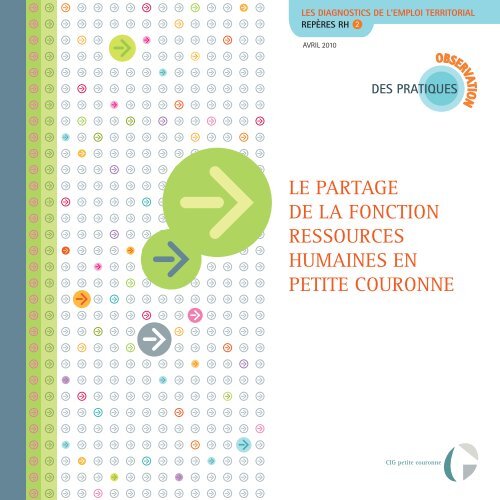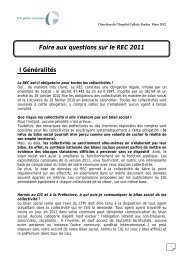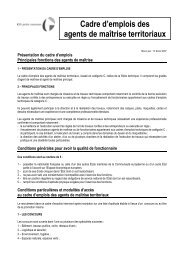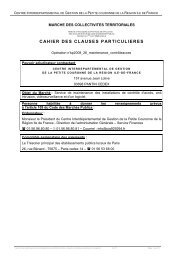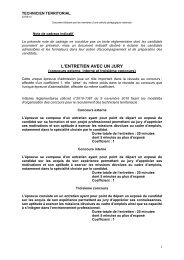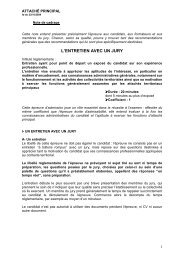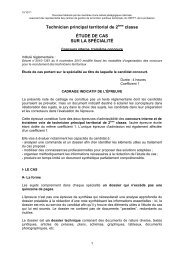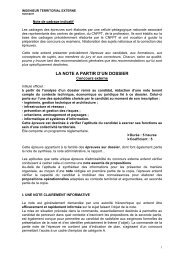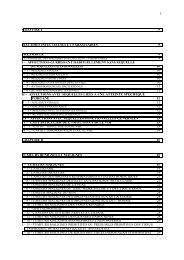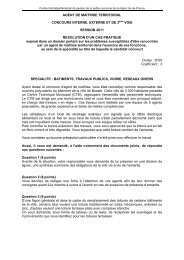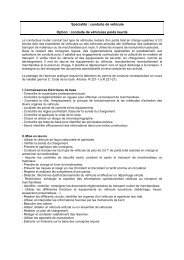le partage de la fonction ressources humaines en petite couronne
le partage de la fonction ressources humaines en petite couronne
le partage de la fonction ressources humaines en petite couronne
Create successful ePaper yourself
Turn your PDF publications into a flip-book with our unique Google optimized e-Paper software.
6 - L’ag<strong>en</strong>tIl <strong>de</strong>vi<strong>en</strong>t acteur <strong>de</strong> sa carrière et <strong>de</strong> son évolution professionnel<strong>le</strong> grâce à un meil<strong>le</strong>ur accès à l’information sur<strong>la</strong> formation, <strong>le</strong>s métiers <strong>de</strong> <strong>la</strong> col<strong>le</strong>ctivité, à sa situation administrative, etc., et pr<strong>en</strong>d davantage d’initiatives.Face aux décisions <strong>de</strong> sa hiérarchie directe, l’ag<strong>en</strong>t doit pouvoir recourir à l’arbitrage du directeur <strong>de</strong>s <strong>ressources</strong><strong>humaines</strong> <strong>en</strong> cas <strong>de</strong> désaccord.7 - Les part<strong>en</strong>airessociauxLes <strong>fonction</strong>naires particip<strong>en</strong>t par l’intermédiaire <strong>de</strong> <strong>le</strong>urs délégués siégeant dans <strong>de</strong>s organismes consultatifs àl’organisation et au <strong>fonction</strong>nem<strong>en</strong>t <strong>de</strong>s services publics, à l’é<strong>la</strong>boration <strong>de</strong>s règ<strong>le</strong>s statutaires et à l’exam<strong>en</strong> <strong>de</strong>sdécisions individuel<strong>le</strong>s re<strong>la</strong>tives à <strong>le</strong>ur carrière.8 - Les part<strong>en</strong>airesexternesIls intervi<strong>en</strong>n<strong>en</strong>t à <strong>la</strong> <strong>de</strong>man<strong>de</strong> <strong>de</strong> <strong>la</strong> GPEEC..., <strong>en</strong> appui méthodologique par exemp<strong>le</strong> dans <strong>la</strong> gestion du changem<strong>en</strong>tou du recrutem<strong>en</strong>t. Le CIG fait partie <strong>de</strong>s part<strong>en</strong>aires externes.» 2.3 Les conditions <strong>de</strong> réussite du projet <strong>de</strong> <strong>partage</strong> <strong>de</strong> <strong>la</strong> <strong>fonction</strong> <strong>ressources</strong> <strong>humaines</strong> (5)QUOI PARTAGER ?PhasesObjectifsConcertation <strong>en</strong>tre <strong>la</strong> direction <strong>de</strong>s <strong>ressources</strong><strong>humaines</strong> et <strong>le</strong>s directions et services• Analyser <strong>le</strong>s att<strong>en</strong>tes respectives <strong>de</strong> <strong>la</strong> direction <strong>de</strong>s<strong>ressources</strong> <strong>humaines</strong> et <strong>de</strong>s directions et services,• Analyser <strong>le</strong>s difficultés RH actuel<strong>le</strong>s et à v<strong>en</strong>ir <strong>de</strong> chaquedirection et service,• Repérer <strong>le</strong>s risques et <strong>le</strong>s craintes respectifs,• Construire une vision partagée du projet.Qui fait quoi ?• Analyser chaque mission RH :- Recrutem<strong>en</strong>t,- Formation,- Mobilité,- Gestion <strong>de</strong>s carrières,- Paye,- Prév<strong>en</strong>tion <strong>de</strong>s risques et santé au travail...• Se mettre d’accord sur <strong>le</strong> <strong>partage</strong> <strong>de</strong>s actions<strong>en</strong>tre part<strong>en</strong>aires (qui fait quoi ?).Les chantiers à réaliser dans <strong>le</strong> cadre du <strong>partage</strong> <strong>de</strong> <strong>la</strong> <strong>fonction</strong> <strong>ressources</strong> <strong>humaines</strong> sont divers. Ils peuv<strong>en</strong>t être priorisés dans un p<strong>la</strong>n d’actions RH.(5) Il s’agit <strong>de</strong> préconisations méthodologiques.7
» 2.4 Les rô<strong>le</strong>s <strong>de</strong>s <strong>de</strong>ux principaux acteurs du <strong>partage</strong> <strong>de</strong> <strong>la</strong> <strong>fonction</strong> <strong>ressources</strong> <strong>humaines</strong>La direction <strong>de</strong>s <strong>ressources</strong> <strong>humaines</strong>• Définit et pilote <strong>la</strong> politique RH <strong>de</strong> <strong>la</strong> col<strong>le</strong>ctivité.• Accompagne et conseil<strong>le</strong> <strong>le</strong>s <strong>en</strong>cadrants pour <strong>la</strong> mise<strong>en</strong> œuvre au sein <strong>de</strong> chaque service <strong>de</strong>s règ<strong>le</strong>s <strong>en</strong> matière<strong>de</strong> gestion <strong>de</strong>s <strong>ressources</strong> <strong>humaines</strong>.• Garantit l’équité <strong>de</strong> traitem<strong>en</strong>t et l’harmonisation <strong>de</strong>srèg<strong>le</strong>s pour l’<strong>en</strong>semb<strong>le</strong> <strong>de</strong> <strong>la</strong> col<strong>le</strong>ctivité.• Arbitre <strong>en</strong> <strong>de</strong>rnier lieu (év<strong>en</strong>tuel<strong>le</strong>m<strong>en</strong>t avec <strong>la</strong> directiongénéra<strong>le</strong>) après l’interv<strong>en</strong>tion préa<strong>la</strong>b<strong>le</strong> <strong>de</strong>s <strong>en</strong>cadrantssur <strong>le</strong>s différ<strong>en</strong>ts processus RH selon <strong>le</strong>s règ<strong>le</strong>spréa<strong>la</strong>b<strong>le</strong>m<strong>en</strong>t définies.• S’assure <strong>de</strong> <strong>la</strong> compréh<strong>en</strong>sion <strong>de</strong>s problématiques RHpar <strong>le</strong>s <strong>en</strong>cadrants pour y répondre au mieux.• Pr<strong>en</strong>d <strong>en</strong> compte <strong>le</strong>s conditions nécessaires au développem<strong>en</strong>t<strong>de</strong>s compét<strong>en</strong>ces managéria<strong>le</strong>s <strong>de</strong> chaque<strong>en</strong>cadrant.• É<strong>la</strong>bore <strong>en</strong> concertation avec <strong>le</strong>s services <strong>le</strong>s différ<strong>en</strong>tsprojets et évolutions <strong>en</strong> matière RH.• Communique et diffuse <strong>le</strong>s élém<strong>en</strong>ts nécessaires à <strong>la</strong>gestion opérationnel<strong>le</strong> <strong>de</strong>s <strong>ressources</strong> <strong>humaines</strong> dans<strong>le</strong>s directions et services.Les <strong>en</strong>cadrants• Réalis<strong>en</strong>t un réel <strong>partage</strong> <strong>de</strong> <strong>la</strong> <strong>fonction</strong> <strong>ressources</strong><strong>humaines</strong> et construis<strong>en</strong>t avec <strong>la</strong> DRH <strong>le</strong>s processus RH.• Particip<strong>en</strong>t, propos<strong>en</strong>t et amélior<strong>en</strong>t <strong>le</strong>s projets RHsous l’impulsion <strong>de</strong> <strong>la</strong> DRH.• Mett<strong>en</strong>t <strong>en</strong> œuvre <strong>le</strong>s règ<strong>le</strong>s <strong>en</strong> matière <strong>de</strong> GRH.• Constitu<strong>en</strong>t <strong>le</strong> premier niveau <strong>de</strong> gestion <strong>en</strong> matière<strong>de</strong> GRH pour <strong>le</strong>s ag<strong>en</strong>ts.• Communiqu<strong>en</strong>t et <strong>partage</strong>nt <strong>de</strong>s informations à <strong>la</strong>DRH sur ce premier niveau <strong>de</strong> gestion dans <strong>le</strong> cadred’échanges réguliers.• Garantiss<strong>en</strong>t <strong>la</strong> mise <strong>en</strong> application <strong>de</strong>s décisionsprises pour chaque situation individuel<strong>le</strong> d’ag<strong>en</strong>t, <strong>en</strong>concertation avec <strong>la</strong> DRH si nécessaire.• Particip<strong>en</strong>t à l’arbitrage et à <strong>la</strong> priorisation <strong>de</strong>s actionsdu service ou <strong>de</strong> <strong>la</strong> direction sur l’<strong>en</strong>semb<strong>le</strong> <strong>de</strong>sthématiques RH <strong>en</strong> <strong>fonction</strong> du positionnem<strong>en</strong>t hiérarchique(directeur, chef <strong>de</strong> service ou autres).9
Zoom sur <strong>le</strong>s pratiques• Première partie : <strong>le</strong> part<strong>en</strong>ariat-RH.• Deuxième partie : l’outil<strong>la</strong>ge. PREMIÈRE PARTIE : LE PARTENARIAT-RH» 3.1 La direction <strong>de</strong>s <strong>ressources</strong> <strong>humaines</strong> : conseil sur l’<strong>en</strong>semb<strong>le</strong> <strong>de</strong>s processus RHZoom sur <strong>le</strong>s pratiquesl Vil<strong>le</strong> <strong>de</strong> Nanterre (92) . . . . . . . . . . . .• Une spécialité affichée <strong>en</strong> matière statutaire. . . . . . . . . . . . . . . . . . . . . . . . . . . . . . . . . . . . . . . . . .p. 11l Vil<strong>le</strong> d’Alfortvil<strong>le</strong> (94) . . . . . . . . . . .• Une posture <strong>de</strong> conseil <strong>en</strong> matière <strong>de</strong> recrutem<strong>en</strong>t. . . . . . . . . . . . . . . . . . . . . . . . . . . . . . . . . . . .p. 12l Vil<strong>le</strong> <strong>de</strong> Vitry-sur-Seine (94) . . . .• L’analyse du besoin <strong>de</strong> formation : résultat d’une construction col<strong>le</strong>ctive . . . . . . . . . . . . .p. 13• L’avis d’une spécialiste sur l’évolution du métier <strong>de</strong> responsab<strong>le</strong> <strong>de</strong> formation . . . . . . . .p. 14l Vil<strong>le</strong> <strong>de</strong> Drancy (93) . . . . . . . . . . . . . .• Un exemp<strong>le</strong> <strong>de</strong> perception du rô<strong>le</strong> du directeur <strong>de</strong>s <strong>ressources</strong> <strong>humaines</strong> . . . . . . . . . . . . .p. 15l Vil<strong>le</strong> <strong>de</strong> Bagno<strong>le</strong>t (93) . . . . . . . . . . .• La réorganisation <strong>de</strong> <strong>la</strong> direction <strong>de</strong>s <strong>ressources</strong> <strong>humaines</strong> :un préa<strong>la</strong>b<strong>le</strong> à <strong>la</strong> mise <strong>en</strong> œuvre du <strong>partage</strong> <strong>de</strong> <strong>la</strong> <strong>fonction</strong> <strong>ressources</strong> <strong>humaines</strong> . . . . . . .p. 16Ec<strong>la</strong>irages méthodologiquesl Une <strong>fonction</strong> <strong>ressources</strong> <strong>humaines</strong> <strong>en</strong> évolution . . . . . . . . . . . . . . . . . . . . . . . . . . . . . . . . . . . . . . . . . . . . . . . . . . . . . . . . . . . . . . . . . . . . . . . . . .p. 19l Des profils spécifiques . . . . . . . . . . . . . . . . . . . . . . . . . . . . . . . . . . . . . . . . . . . . . . . . . . . . . . . . . . . . . . . . . . . . . . . . . . . . . . . . . . . . . . . . . . . . . . . . . . . . . .p. 20Page10
UNE SPÉCIALITÉ AFFICHÉE EN MATIÈRE STATUTAIREEntreti<strong>en</strong> avec <strong>le</strong> directeur <strong>de</strong>s <strong>ressources</strong> <strong>humaines</strong>, <strong>la</strong> conseillère technique à <strong>la</strong> direction <strong>de</strong>s <strong>ressources</strong> <strong>humaines</strong> et <strong>la</strong> responsab<strong>le</strong> du pô<strong>le</strong>emploi et formation.Positionnem<strong>en</strong>t dans l’organigramme :- Le directeur <strong>de</strong>s <strong>ressources</strong> <strong>humaines</strong> est sous l’autorité hiérarchique du directeur général <strong>de</strong>s services.- La conseillère technique ainsi que <strong>la</strong> responsab<strong>le</strong> du pô<strong>le</strong> emploi et formation sont sous l’autorité hiérarchique du directeur <strong>de</strong>s <strong>ressources</strong><strong>humaines</strong>.• Vil<strong>le</strong> <strong>de</strong> Nanterre (92) – 90 368 habitants, 3 221 ag<strong>en</strong>tsL’approche statutaire pr<strong>en</strong>d une p<strong>la</strong>ce importante dans l’organisation<strong>de</strong> <strong>la</strong> <strong>fonction</strong> <strong>ressources</strong> <strong>humaines</strong> <strong>de</strong> <strong>la</strong> vil<strong>le</strong> <strong>de</strong> Nanterrecomme <strong>le</strong> montre l’exist<strong>en</strong>ce d’un poste <strong>de</strong> conseil<strong>le</strong>r techniqueet juridique, <strong>en</strong> charge <strong>de</strong> <strong>la</strong> veil<strong>le</strong> statutaire et <strong>de</strong> <strong>la</strong> docum<strong>en</strong>tation,<strong>de</strong> <strong>la</strong> rédaction <strong>de</strong>s rapports cont<strong>en</strong>tieux et <strong>de</strong>s mémoires.Il conseil<strong>le</strong> et accompagne l’<strong>en</strong>semb<strong>le</strong> <strong>de</strong>s acteurs <strong>de</strong> <strong>la</strong> <strong>fonction</strong>RH : ag<strong>en</strong>ts, cadres, réseau <strong>de</strong>s référ<strong>en</strong>ts RH pour une bonne compréh<strong>en</strong>sion<strong>de</strong>s règ<strong>le</strong>s du statut.• Ce rô<strong>le</strong> <strong>de</strong> conseil et d’accompagnem<strong>en</strong>t s’illustre particulièrem<strong>en</strong>tpar <strong>la</strong> démarche <strong>de</strong> formation et <strong>de</strong> transmission d’uneculture RH.Par exemp<strong>le</strong>, <strong>le</strong> conseil<strong>le</strong>r technique a mis <strong>en</strong> p<strong>la</strong>ce <strong>de</strong>s actions <strong>de</strong>formation à <strong>de</strong>stination du réseau <strong>de</strong>s référ<strong>en</strong>ts pour expliquer <strong>de</strong>sréformes (comme cel<strong>le</strong> <strong>de</strong> <strong>la</strong> formation ou <strong>de</strong>s retraites) et <strong>la</strong> gestionadministrative <strong>de</strong> <strong>la</strong> carrière : <strong>le</strong>s référ<strong>en</strong>ts RH ont manifestéun réel intérêt. Actuel<strong>le</strong>m<strong>en</strong>t, <strong>le</strong>s formations sont plus espacéeset sont organisées à l’occasion <strong>de</strong>s changem<strong>en</strong>ts importants dustatut.L’objectif <strong>de</strong> ces formations est <strong>de</strong> transmettre un vocabu<strong>la</strong>ire et<strong>de</strong>s outils communs : ainsi, <strong>le</strong> référ<strong>en</strong>t RH participe <strong>de</strong> <strong>la</strong> bonneapplication <strong>de</strong>s règ<strong>le</strong>s <strong>de</strong> GRH <strong>en</strong> assurant par exemp<strong>le</strong> <strong>le</strong> respect<strong>de</strong> <strong>la</strong> mise <strong>en</strong> œuvre <strong>de</strong> <strong>la</strong> procédure <strong>de</strong> notation dans <strong>le</strong>s services.Ces formations permett<strong>en</strong>t éga<strong>le</strong>m<strong>en</strong>t une meil<strong>le</strong>ure compréh<strong>en</strong>sionet appropriation <strong>de</strong> <strong>la</strong> politique <strong>de</strong> GRH et constitu<strong>en</strong>t<strong>de</strong>s temps pour expliquer <strong>le</strong> rô<strong>le</strong> <strong>de</strong> <strong>la</strong> direction <strong>de</strong>s <strong>ressources</strong><strong>humaines</strong> aux différ<strong>en</strong>ts acteurs <strong>de</strong> <strong>la</strong> <strong>fonction</strong> RH.• Le rô<strong>le</strong> <strong>de</strong> conseil s’illustre aussi par <strong>la</strong> création d’une base <strong>de</strong>référ<strong>en</strong>ces juridiques disponib<strong>le</strong>s sur <strong>le</strong> réseau <strong>de</strong> <strong>la</strong> vil<strong>le</strong> et réservéesaux référ<strong>en</strong>ts RH.• Une importante mobilisation <strong>de</strong>s différ<strong>en</strong>ts spécialistes lors <strong>de</strong>sactions <strong>de</strong> formation (par exemp<strong>le</strong>, <strong>de</strong>s binômes avec <strong>le</strong> responsab<strong>le</strong><strong>de</strong> <strong>la</strong> gestion administrative, ou avec <strong>le</strong> responsab<strong>le</strong> du pô<strong>le</strong> formationet emploi peuv<strong>en</strong>t être mis <strong>en</strong> p<strong>la</strong>ce) montre une volonté <strong>de</strong>l’<strong>en</strong>semb<strong>le</strong> <strong>de</strong> <strong>la</strong> DRH d’être à l’écoute <strong>de</strong>s acteurs <strong>de</strong> <strong>la</strong> <strong>fonction</strong> RH.Ce positionnem<strong>en</strong>t <strong>de</strong> conseil suppose <strong>de</strong> <strong>la</strong> pédagogie et <strong>la</strong> prise <strong>en</strong>compte <strong>de</strong>s différ<strong>en</strong>tes att<strong>en</strong>tes d’un public hétérogène <strong>de</strong> cadres et<strong>de</strong> référ<strong>en</strong>ts RH pour faciliter <strong>la</strong> compréh<strong>en</strong>sion du statut.11
UNE POSTURE DE CONSEIL EN MATIÈRE DE RECRUTEMENTEntreti<strong>en</strong> avec <strong>la</strong> DGA <strong>en</strong> charge <strong>de</strong>s <strong>ressources</strong> <strong>humaines</strong>, <strong>de</strong>s affaires généra<strong>le</strong>s, <strong>de</strong> <strong>la</strong> santé, <strong>de</strong> l’accueil, <strong>de</strong> l’<strong>en</strong>treti<strong>en</strong>, et <strong>de</strong> <strong>la</strong> restaurationsco<strong>la</strong>ire, et <strong>le</strong> directeur <strong>de</strong>s <strong>ressources</strong> <strong>humaines</strong>.Positionnem<strong>en</strong>t dans l’organigramme :- Le directeur <strong>de</strong>s <strong>ressources</strong> <strong>humaines</strong> est sous l’autorité hiérarchique <strong>de</strong> <strong>la</strong> DGA.• Vil<strong>le</strong> d’Alfortvil<strong>le</strong> (94) - 42 994 habitants, 657 ag<strong>en</strong>tsLa réc<strong>en</strong>te culture RH <strong>de</strong> <strong>la</strong> vil<strong>le</strong> d’Alfortvil<strong>le</strong> a été impulsée par <strong>la</strong>mise <strong>en</strong> p<strong>la</strong>ce <strong>de</strong> formations au managem<strong>en</strong>t auprès <strong>de</strong>s directeurs,chefs <strong>de</strong> services et cadres <strong>de</strong> proximité (suite au constatd’une logique <strong>de</strong> gestion statutaire uniquem<strong>en</strong>t).El<strong>le</strong> se concrétise notamm<strong>en</strong>t par un part<strong>en</strong>ariat plus constantdans <strong>le</strong> processus <strong>de</strong> recrutem<strong>en</strong>t <strong>en</strong>tre <strong>la</strong> DRH et <strong>le</strong>s services. Eneffet, certains services agissant <strong>de</strong> manière autonome, et <strong>la</strong> DRHn’étant pas i<strong>de</strong>ntifiée comme <strong>le</strong> pilier <strong>de</strong> chaque recrutem<strong>en</strong>t, unedéperdition <strong>de</strong> candidatures et un manque d’égalité <strong>de</strong> traitem<strong>en</strong>t<strong>de</strong>s candidats sont constatées.D’où une volonté forte <strong>de</strong> définir col<strong>le</strong>ctivem<strong>en</strong>t une procédurepour harmoniser <strong>le</strong>s pratiques <strong>de</strong> recrutem<strong>en</strong>t. Cette procédure apour objet d’optimiser l’organisation <strong>de</strong>s recrutem<strong>en</strong>ts effectuésau sein <strong>de</strong>s services <strong>de</strong> <strong>la</strong> vil<strong>le</strong> et du c<strong>en</strong>tre communal d’actionsocia<strong>le</strong> (CCAS) afin :• De conforter <strong>le</strong> traitem<strong>en</strong>t interne i<strong>de</strong>ntique et égalitaire <strong>de</strong>scandidatures,• De permettre une présé<strong>le</strong>ction <strong>de</strong>s profils,• D’i<strong>de</strong>ntifier <strong>le</strong>s candidatures à fort pot<strong>en</strong>tiel, notamm<strong>en</strong>t pour <strong>le</strong>ssecteurs <strong>en</strong> difficulté <strong>de</strong> recrutem<strong>en</strong>t ou à forte expertise,• D’accroître l’efficacité <strong>de</strong> <strong>le</strong>ur suivi interne et <strong>la</strong> communicationd’informations <strong>en</strong>tre <strong>la</strong> DRH et <strong>le</strong>s services recruteurs,• D’accompagner <strong>le</strong>s recrutem<strong>en</strong>ts au sein <strong>de</strong>s services par un apportd’élém<strong>en</strong>ts statutaires et financiers par <strong>la</strong> DRH,• De permettre plus <strong>de</strong> rapidité et <strong>de</strong> réactivité nécessaires à <strong>la</strong>finalisation <strong>de</strong> certains recrutem<strong>en</strong>ts.Concrètem<strong>en</strong>t, un candidat est reçu par <strong>de</strong>ux commissions distinctescomposées <strong>de</strong> cadres, parfois d’élus, avant d’être recruté. Lefutur employé dispose ainsi <strong>de</strong>s principa<strong>le</strong>s informations uti<strong>le</strong>s dèsson arrivée et i<strong>de</strong>ntifie ses interlocuteurs à v<strong>en</strong>ir. Son intégrationest facilitée.La nouvel<strong>le</strong> procédure a été validée par <strong>la</strong> direction généra<strong>le</strong> <strong>de</strong>sservices, garante du projet <strong>de</strong> <strong>partage</strong> <strong>de</strong> <strong>la</strong> <strong>fonction</strong> RH. Le souti<strong>en</strong><strong>de</strong>s membres <strong>de</strong> <strong>la</strong> direction généra<strong>le</strong> est ess<strong>en</strong>tiel pour légitimerl’action <strong>de</strong> <strong>la</strong> DRH vis-à-vis <strong>de</strong>s cadres et <strong>de</strong>s ag<strong>en</strong>ts. La règ<strong>le</strong> est<strong>le</strong> part<strong>en</strong>ariat. A travers <strong>le</strong> processus <strong>de</strong> recrutem<strong>en</strong>t, <strong>le</strong>s spécialistesRH doiv<strong>en</strong>t accompagner progressivem<strong>en</strong>t <strong>le</strong>s directions etservices dans une démarche <strong>de</strong> maîtrise <strong>de</strong> <strong>la</strong> masse sa<strong>la</strong>ria<strong>le</strong> et<strong>de</strong> gestion prévisionnel<strong>le</strong> <strong>de</strong>s emplois, <strong>de</strong>s effectifs et <strong>de</strong>s compét<strong>en</strong>ces(GPEEC).Le part<strong>en</strong>ariat se traduit notamm<strong>en</strong>t par :• L’analyse col<strong>le</strong>ctive <strong>de</strong>s besoins <strong>en</strong> amont <strong>de</strong> chaque recrutem<strong>en</strong>t(réalisation d’une projection financière à 3 ans pour anticiper <strong>le</strong>ssc<strong>en</strong>arii d’organisations possib<strong>le</strong>s, <strong>le</strong>s départs <strong>en</strong> retraite prévisib<strong>le</strong>s,et se poser <strong>de</strong>s questions tel<strong>le</strong>s que : faut-il reconduire <strong>le</strong>poste à l’i<strong>de</strong>ntique ? quel<strong>le</strong>s formations mettre <strong>en</strong> p<strong>la</strong>ce pour faire12
évoluer <strong>le</strong>s compét<strong>en</strong>ces disponib<strong>le</strong>s ? quel<strong>le</strong> nouvel<strong>le</strong> répartition<strong>de</strong>s missions au sein du service ? quel<strong>le</strong> évolution <strong>en</strong>visageab<strong>le</strong>pour <strong>le</strong>s collègues <strong>en</strong> poste ? etc.)• La prés<strong>en</strong>ce du directeur <strong>de</strong>s <strong>ressources</strong> <strong>humaines</strong> ou d’un chargé<strong>de</strong> recrutem<strong>en</strong>t à chaque <strong>en</strong>treti<strong>en</strong>.Des outils ont été mis <strong>en</strong> p<strong>la</strong>ce :• La création d’une candidathèque à <strong>la</strong> DRH et une mise à disposition<strong>de</strong> curriculum vitae et <strong>de</strong>man<strong>de</strong>s d’emplois actualisés au sein<strong>de</strong>s services recruteurs,• Des fiches <strong>de</strong> <strong>de</strong>man<strong>de</strong> <strong>de</strong> recrutem<strong>en</strong>t (temporaires ou définitives)responsabilisant <strong>le</strong> service recruteur quant à l’impact financieret <strong>la</strong> nécessité du poste <strong>de</strong>mandé,• Des fiches <strong>de</strong> souti<strong>en</strong> aux commissions d’<strong>en</strong>treti<strong>en</strong> <strong>de</strong> recrutem<strong>en</strong>t.Depuis <strong>le</strong> 1 er octobre 2009, cette procédure est appliquée auxrecrutem<strong>en</strong>ts externes et à <strong>la</strong> mobilité interne qui doit être favorisée.Une bourse interne à l’emploi est systématiquem<strong>en</strong>tproposée. Une réorganisation <strong>de</strong> <strong>la</strong> DRH visant à définitivem<strong>en</strong>tinstal<strong>le</strong>r cette logique <strong>de</strong> GPEEC est prévue pour <strong>le</strong> premiersemestre 2010. D’autres projets liés à cette démarche sont à l’étu<strong>de</strong>(l’accompagnem<strong>en</strong>t <strong>de</strong> <strong>la</strong> reprise d’activité après une ma<strong>la</strong>die, unecommission interne d’étu<strong>de</strong> <strong>de</strong>s mobilités, une nouvel<strong>le</strong> procédured’accueil <strong>de</strong>s nouveaux arrivants, un support partagé <strong>de</strong> suivi <strong>de</strong> <strong>la</strong>masse sa<strong>la</strong>ria<strong>le</strong>, etc.).L’ANALYSE DU BESOIN DE FORMATION : RÉSULTAT D’UNE CONSTRUCTION COLLECTIVEEntreti<strong>en</strong> avec <strong>le</strong> DGA-RH et <strong>la</strong> responsab<strong>le</strong> <strong>de</strong> <strong>la</strong> formation.Positionnem<strong>en</strong>t dans l’organigramme :- La responsab<strong>le</strong> <strong>de</strong> <strong>la</strong> formation est sous l’autorité hiérarchique du directeur adjoint <strong>de</strong> <strong>la</strong> gestion <strong>de</strong>s effectifs et <strong>de</strong>s <strong>ressources</strong> <strong>humaines</strong>au sein <strong>de</strong> <strong>la</strong> direction <strong>de</strong>s <strong>ressources</strong> <strong>humaines</strong> pilotée par <strong>le</strong> DGA-RH.• Vil<strong>le</strong> <strong>de</strong> Vitry-sur-Seine (94) – 83 559 habitants, 2 434 ag<strong>en</strong>tsLe service formation s’est structuré au fil du temps : il est passé d’unepolitique basée ess<strong>en</strong>tiel<strong>le</strong>m<strong>en</strong>t sur du « prêt à former » commandé surcatalogue à une démarche intégrant aussi <strong>le</strong> « sur mesure » pour être auplus près <strong>de</strong>s missions et besoins <strong>de</strong> <strong>la</strong> col<strong>le</strong>ctivité et <strong>de</strong> ses ag<strong>en</strong>ts. Cettedémarche plus exigeante implique éga<strong>le</strong>m<strong>en</strong>t plus <strong>de</strong> compét<strong>en</strong>ces, plus<strong>de</strong> moy<strong>en</strong>s. Le service formation concerte <strong>le</strong>s services, rédige <strong>de</strong>s cahiers<strong>de</strong>s charges, consulte <strong>le</strong>s formateurs – <strong>de</strong> préfér<strong>en</strong>ce <strong>le</strong> CNFPT- pourconstruire avec eux <strong>de</strong>s programmes au plus près <strong>de</strong>s besoins, si possib<strong>le</strong>pour <strong>de</strong>s stages qui se dérou<strong>le</strong>ront à Vitry-sur-Seine, ce qui induit aussique <strong>le</strong> service coordonne <strong>la</strong> logistique.L’analyse du besoin <strong>de</strong> formation est une réel<strong>le</strong> coproduction <strong>de</strong>sacteurs-clés <strong>de</strong> <strong>la</strong> <strong>fonction</strong> RH : ag<strong>en</strong>t, supérieur hiérarchique etspécialistes <strong>de</strong> <strong>la</strong> formation se concert<strong>en</strong>t suivant un processusapproprié par tous <strong>de</strong>puis plusieurs années, dans <strong>la</strong> transpar<strong>en</strong>ce.Chaque année se ti<strong>en</strong>t dans chaque service aux mois <strong>de</strong> mai/juin,une évaluation col<strong>le</strong>ctive <strong>en</strong> prés<strong>en</strong>ce <strong>de</strong> tous <strong>le</strong>s ag<strong>en</strong>ts. Schématiquem<strong>en</strong>t,el<strong>le</strong> s’organise <strong>en</strong> <strong>de</strong>ux parties : <strong>le</strong> bi<strong>la</strong>n <strong>de</strong> <strong>la</strong> pério<strong>de</strong>antérieure et donc <strong>la</strong> comparaison <strong>en</strong>tre <strong>la</strong> prévision et <strong>la</strong> réalité,puis <strong>la</strong> définition <strong>de</strong>s objectifs du service pour l’av<strong>en</strong>ir, qui ti<strong>en</strong>n<strong>en</strong>tcompte comme il se doit, <strong>de</strong>s ori<strong>en</strong>tations municipa<strong>le</strong>s. Mais <strong>le</strong>s13
ag<strong>en</strong>ts peuv<strong>en</strong>t éga<strong>le</strong>m<strong>en</strong>t mettre <strong>en</strong> débat <strong>le</strong>urs propres préoccupationsliées par exemp<strong>le</strong> à l’organisation ou aux conditions <strong>de</strong>travail.Ensuite, à partir <strong>de</strong>s mois <strong>de</strong> juin/juil<strong>le</strong>t, ont lieu <strong>le</strong>s évaluationsindividuel<strong>le</strong>s avec <strong>le</strong> même schéma mais <strong>en</strong> déclinant quel<strong>le</strong> parta pris ou pr<strong>en</strong>dra l’ag<strong>en</strong>t dans l’accomplissem<strong>en</strong>t <strong>de</strong>s objectifs duservice. Des formations peuv<strong>en</strong>t être à <strong>la</strong> c<strong>le</strong>f. Mais l’ag<strong>en</strong>t peutaussi avoir <strong>de</strong>s ambitions plus personnel<strong>le</strong>s, comme préparer unconcours pour accé<strong>de</strong>r à un gra<strong>de</strong> supérieur, qui seront aussi prises<strong>en</strong> compte.Les métho<strong>de</strong>s et outils <strong>de</strong> l’ingénierie <strong>de</strong> <strong>la</strong> formation se sont beaucoupdéveloppés <strong>de</strong>puis 2004 pour remp<strong>la</strong>cer au fur et à mesurel’achat <strong>de</strong> formation sur catalogue. En effet, <strong>le</strong>s spécialistes <strong>de</strong> <strong>la</strong>formation se charg<strong>en</strong>t du montage <strong>de</strong> <strong>la</strong> formation <strong>en</strong> analysant<strong>le</strong>s retours <strong>de</strong>s évaluations.Ainsi, ils peuv<strong>en</strong>t se rapprocher du supérieur hiérarchique directqui participe à l’instruction et vali<strong>de</strong> <strong>le</strong> cahier <strong>de</strong>s charges <strong>de</strong> formation.Ils interrog<strong>en</strong>t <strong>le</strong>s ag<strong>en</strong>ts éga<strong>le</strong>m<strong>en</strong>t qui vont partir <strong>en</strong>formation pour <strong>le</strong>s faire adhérer <strong>le</strong> plus <strong>en</strong> amont possib<strong>le</strong> au projet<strong>de</strong> formation. Cette approche est très appréciée.La réponse est personnalisée : information, formation individualisée,formation intra pour accompagner une réorganisation etc.Par exemp<strong>le</strong>, <strong>le</strong> p<strong>la</strong>n <strong>de</strong> formation 2010 prévoit <strong>la</strong> poursuite d’accompagnem<strong>en</strong>tdu c<strong>en</strong>tre municipal <strong>de</strong> santé (CMS) dans <strong>la</strong> réorganisation<strong>de</strong> ses accueils, ou <strong>en</strong>core, <strong>la</strong> poursuite d’actions <strong>de</strong> formation<strong>de</strong>s ATSEM (gestes et postures, développem<strong>en</strong>t <strong>de</strong> l’<strong>en</strong>fant,HACCP, etc.).Le service formation assure donc un rô<strong>le</strong> d’assistance et <strong>de</strong> coordinationpour créer <strong>la</strong> confiance et l’adhésion au projet <strong>de</strong> formation,<strong>la</strong> cohésion <strong>de</strong>s différ<strong>en</strong>tes données <strong>de</strong> <strong>la</strong> formation. Il estgarant <strong>de</strong> <strong>la</strong> réussite <strong>de</strong> cette production col<strong>le</strong>ctive.Un travail d’anticipation est nécessaire pour <strong>le</strong>s formations individuel<strong>le</strong>s: <strong>en</strong> effet, <strong>le</strong>s fiches <strong>de</strong> recueil <strong>de</strong> besoin <strong>de</strong> formation sontintégrées dans <strong>le</strong> p<strong>la</strong>n <strong>de</strong> formation <strong>de</strong> l’année n+2. De plus, <strong>le</strong>service formation t<strong>en</strong>te <strong>de</strong> satisfaire <strong>le</strong>s besoins exprimés l’annéequi suit <strong>en</strong> constituant <strong>de</strong>s « listes d’att<strong>en</strong>te » d’ag<strong>en</strong>ts.L’AVIS D’UNE SPÉCIALISTE SUR L’ÉVOLUTION DU MÉTIER DE RESPONSABLE DE FORMATION• Vil<strong>le</strong> <strong>de</strong> Vitry-sur-Seine (94) – 83 559 habitants, 2 434 ag<strong>en</strong>tsPlusieurs facteurs expliqu<strong>en</strong>t l’évolution du métier <strong>de</strong> <strong>la</strong> formationvers <strong>le</strong> conseil et l’ori<strong>en</strong>tation professionnel<strong>le</strong> : <strong>la</strong> réforme <strong>de</strong><strong>la</strong> formation, <strong>le</strong>s départs <strong>en</strong> retraite, <strong>la</strong> mobilité <strong>de</strong>s ag<strong>en</strong>ts, <strong>le</strong>srec<strong>la</strong>ssem<strong>en</strong>ts, etc.Les spécialistes <strong>de</strong> <strong>la</strong> formation <strong>de</strong>vront savoir anticiper <strong>le</strong>s évolutions<strong>de</strong>s métiers <strong>de</strong> <strong>la</strong> col<strong>le</strong>ctivité pour apporter une réponseadaptée dans <strong>le</strong> traitem<strong>en</strong>t <strong>de</strong>s parcours individuels.Le développem<strong>en</strong>t du service formation vers un « managem<strong>en</strong>t par<strong>le</strong>s compét<strong>en</strong>ces » passera par <strong>le</strong> pilotage <strong>de</strong> projets transversauxassociant différ<strong>en</strong>ts acteurs - directeur <strong>de</strong>s <strong>ressources</strong> <strong>humaines</strong>,direction généra<strong>le</strong>, etc. -, différ<strong>en</strong>ts outils - droit individuel à <strong>la</strong>formation (DIF), livret individuel <strong>de</strong> formation (LIF), validation <strong>de</strong>sacquis <strong>de</strong> l’expéri<strong>en</strong>ce (VAE), évaluations, pyramidage <strong>de</strong>s départs<strong>en</strong> retraite, métiers <strong>en</strong> évolution ou <strong>en</strong> voie d’extinction, etc. - afin<strong>de</strong> répondre à <strong>de</strong> nouvel<strong>le</strong>s problématiques voire aux exig<strong>en</strong>cesliées à un contexte global <strong>en</strong> gran<strong>de</strong> mutation - réforme <strong>de</strong> <strong>la</strong>formation, loi sur <strong>la</strong> mobilité, GPEEC, etc.14
Il s’agit d’apporter <strong>de</strong>s réponses à diverses situations : formation<strong>de</strong>s ag<strong>en</strong>ts <strong>en</strong> restriction médica<strong>le</strong> pour un rec<strong>la</strong>ssem<strong>en</strong>t ou unchangem<strong>en</strong>t <strong>de</strong> métier, préparation d’un retour à l’emploi, anticipation<strong>de</strong>s aménagem<strong>en</strong>ts <strong>de</strong> postes par exemp<strong>le</strong> suite à un remp<strong>la</strong>cem<strong>en</strong>t,etc.Le responsab<strong>le</strong> <strong>de</strong> formation <strong>de</strong>vra piloter <strong>de</strong>s projets transversauxassociant plusieurs part<strong>en</strong>aires <strong>de</strong> <strong>la</strong> <strong>fonction</strong> RH : <strong>la</strong> directiongénéra<strong>le</strong>, <strong>le</strong>s chefs <strong>de</strong> services, <strong>le</strong>s part<strong>en</strong>aires sociaux.Par exemp<strong>le</strong> : un état <strong>de</strong>s lieux <strong>de</strong>s <strong>ressources</strong> <strong>humaines</strong> <strong>de</strong> <strong>la</strong>col<strong>le</strong>ctivité, <strong>de</strong>s projections <strong>de</strong>s départs <strong>en</strong> retraite et <strong>de</strong>s mobilités.Il <strong>de</strong>vra éga<strong>le</strong>m<strong>en</strong>t réfléchir à une association pertin<strong>en</strong>te du DIFavec <strong>le</strong>s autres formations inscrites au p<strong>la</strong>n <strong>de</strong> <strong>la</strong> vil<strong>le</strong> pour unevéritab<strong>le</strong> gestion prévisionnel<strong>le</strong> <strong>de</strong>s compét<strong>en</strong>ces.La mise <strong>en</strong> œuvre du DIF peut faire évoluer <strong>le</strong>s activités <strong>de</strong>sgestionnaires <strong>de</strong> <strong>la</strong> formation : gestion <strong>de</strong>s comptes <strong>de</strong> formationsur <strong>le</strong> logiciel INSER, gestion <strong>de</strong>s refus du DIF, calcul <strong>de</strong>s droitssuivant <strong>le</strong>s modalités <strong>de</strong> temps <strong>de</strong> travail <strong>de</strong> chaque ag<strong>en</strong>t, etc.Le livret individuel <strong>de</strong> formation, outil <strong>de</strong> développem<strong>en</strong>t duparcours professionnel <strong>de</strong>s ag<strong>en</strong>ts, peut favoriser <strong>le</strong> travail <strong>en</strong>commun <strong>en</strong>tre <strong>le</strong>s différ<strong>en</strong>ts acteurs <strong>de</strong> <strong>la</strong> formation. Par exemp<strong>le</strong>,<strong>le</strong> service formation peut animer <strong>de</strong>s ateliers à <strong>de</strong>stination <strong>de</strong>sag<strong>en</strong>ts <strong>en</strong>gagés dans un projet professionnel <strong>de</strong> reconversion et<strong>de</strong> mobilité.Les <strong>en</strong>cadrants pourront être directem<strong>en</strong>t acteurs dans <strong>la</strong>démarche lors <strong>de</strong>s <strong>en</strong>treti<strong>en</strong>s individuels <strong>de</strong> formation (analyse dubesoin, remplissage du LIF, suivi du parcours <strong>de</strong>s ag<strong>en</strong>ts).Le règ<strong>le</strong>m<strong>en</strong>t <strong>de</strong> <strong>la</strong> formation peut être un support pour éc<strong>la</strong>irer<strong>le</strong>s différ<strong>en</strong>ts acteurs sur <strong>le</strong>s démarches <strong>de</strong> formation : gui<strong>de</strong> pratiquepour l’ag<strong>en</strong>t pour connaître ses droits et ses interlocuteurs,moy<strong>en</strong> <strong>de</strong> communication pour <strong>le</strong> service formation et gui<strong>de</strong> pratiquepour <strong>le</strong>s <strong>en</strong>cadrants (par exemp<strong>le</strong> : <strong>le</strong>s sc<strong>en</strong>arii <strong>de</strong> formationpossib<strong>le</strong>s pourront être définis).UN EXEMPLE DE PERCEPTION DU RÔLE DU DIRECTEUR DES RESSOURCES HUMAINESLe point <strong>de</strong> vue <strong>de</strong> <strong>la</strong> DGA-RH• Vil<strong>le</strong> <strong>de</strong> Drancy (93) – 66 701 habitants, 1 601 ag<strong>en</strong>tsLe directeur <strong>de</strong>s <strong>ressources</strong> <strong>humaines</strong> conseil<strong>le</strong> et accompagnel’<strong>en</strong>semb<strong>le</strong> <strong>de</strong>s acteurs <strong>de</strong> <strong>la</strong> <strong>fonction</strong> RH. Il se charge <strong>de</strong> :1 - Recueillir <strong>le</strong>s informations sur <strong>le</strong>s projets <strong>de</strong>s servicesLe directeur <strong>de</strong>s <strong>ressources</strong> <strong>humaines</strong> s’informe <strong>de</strong> tous <strong>le</strong>s projetspour anticiper <strong>le</strong>s évolutions <strong>de</strong>s métiers et d’organisation. Cette« capture » <strong>de</strong>s informations est facilitée par <strong>le</strong> positionnem<strong>en</strong>tdu DGA-RH au sein <strong>de</strong> <strong>la</strong> direction généra<strong>le</strong> et <strong>le</strong>s modalités <strong>de</strong><strong>fonction</strong>nem<strong>en</strong>t avec l’employeur territorial.L’information est <strong>en</strong>suite transmise par <strong>le</strong> directeur <strong>de</strong>s <strong>ressources</strong><strong>humaines</strong>, par exemp<strong>le</strong> lors <strong>de</strong> réf<strong>le</strong>xions avec <strong>le</strong>s directions et <strong>le</strong>sservices à l’occasion <strong>de</strong>s réorganisations ou <strong>de</strong>s redéploiem<strong>en</strong>ts.Il s’agit <strong>de</strong> faire évoluer <strong>le</strong>s compét<strong>en</strong>ces disponib<strong>le</strong>s pour être <strong>en</strong>adéquation avec <strong>le</strong>s projets <strong>de</strong> <strong>la</strong> col<strong>le</strong>ctivité.2 - Conseil<strong>le</strong>r <strong>le</strong>s différ<strong>en</strong>ts acteurs <strong>de</strong> <strong>la</strong> gestion <strong>de</strong>s <strong>ressources</strong><strong>humaines</strong>Le directeur <strong>de</strong>s <strong>ressources</strong> <strong>humaines</strong> a<strong>le</strong>rte <strong>le</strong> maire et <strong>la</strong> direc-15
tion généra<strong>le</strong> sur <strong>le</strong> statut et <strong>le</strong>s risques juridiques et s<strong>en</strong>sibiliseprogressivem<strong>en</strong>t l’<strong>en</strong>cadrem<strong>en</strong>t à une culture RH commune. Sinécessaire, il reçoit <strong>le</strong>s ag<strong>en</strong>ts notamm<strong>en</strong>t s’il repère <strong>de</strong>s dys<strong>fonction</strong>nem<strong>en</strong>ts.3 - Communiquer avec l’extérieurLe directeur <strong>de</strong>s <strong>ressources</strong> <strong>humaines</strong> peut agir pour r<strong>en</strong>dre l’image<strong>de</strong> <strong>la</strong> col<strong>le</strong>ctivité plus attractive notamm<strong>en</strong>t dans <strong>la</strong> rédaction <strong>de</strong>sannonces et faciliter ainsi <strong>le</strong>s recrutem<strong>en</strong>ts <strong>de</strong>s cadres, par exemp<strong>le</strong>.4 - Assurer du li<strong>en</strong> et du liant <strong>en</strong>tre <strong>le</strong>s différ<strong>en</strong>ts acteurs <strong>de</strong> <strong>la</strong>gestion <strong>de</strong>s <strong>ressources</strong> <strong>humaines</strong>Le directeur <strong>de</strong>s <strong>ressources</strong> <strong>humaines</strong> assure <strong>le</strong> li<strong>en</strong> <strong>en</strong>tre <strong>le</strong>s différ<strong>en</strong>tsspécialistes au sein <strong>de</strong> sa direction pour une approche plus<strong>la</strong>rge que <strong>le</strong> statut.Le directeur <strong>de</strong>s <strong>ressources</strong> <strong>humaines</strong> fixe <strong>le</strong>s règ<strong>le</strong>s du part<strong>en</strong>ariat-RHet chaque acteur (ag<strong>en</strong>t, <strong>en</strong>cadrant) effectue unedémarche individuel<strong>le</strong>. Les réponses sont étudiées <strong>en</strong>semb<strong>le</strong> : <strong>la</strong>GRH est donc une coproduction.Il développe <strong>le</strong> dialogue avec l’<strong>en</strong>cadrem<strong>en</strong>t au quotidi<strong>en</strong>. Cettecommunication est pédagogique : par exemp<strong>le</strong>, <strong>le</strong>s départs <strong>en</strong> retrait<strong>en</strong>on remp<strong>la</strong>cés et <strong>le</strong>s redéploiem<strong>en</strong>ts <strong>de</strong>s <strong>ressources</strong> existantesdoiv<strong>en</strong>t être expliqués. La connaissance <strong>de</strong>s métiers et <strong>de</strong>l’organisation <strong>de</strong>s services est donc nécessaire pour une gestion<strong>de</strong>s / et par <strong>le</strong>s compét<strong>en</strong>ces.La réussite <strong>de</strong> ce part<strong>en</strong>ariat-RH passe parfois par <strong>la</strong> démonstrationd’exemp<strong>le</strong>s <strong>de</strong> réussite, et nécessite <strong>de</strong> <strong>la</strong> disponibilité et <strong>de</strong>l’écoute.Les propositions d’amélioration du directeur <strong>de</strong> l’<strong>en</strong>fance et <strong>de</strong> <strong>la</strong> jeunesseDes pistes d’amélioration du part<strong>en</strong>ariat-RH sont possib<strong>le</strong>s commepar exemp<strong>le</strong> :• La communication <strong>de</strong> tab<strong>le</strong>aux <strong>de</strong> bord m<strong>en</strong>suels <strong>de</strong>s dép<strong>en</strong>ses<strong>de</strong> personnel par secteur (gar<strong>de</strong>rie, cantine) pour un meil<strong>le</strong>ur suivi<strong>de</strong>s dép<strong>en</strong>ses et pour <strong>la</strong> construction du budget,• Une évaluation <strong>de</strong> <strong>la</strong> pertin<strong>en</strong>ce du travail effectué par <strong>le</strong>s directionsdans <strong>le</strong> domaine <strong>de</strong> <strong>la</strong> <strong>fonction</strong> RH par <strong>la</strong> mise <strong>en</strong> p<strong>la</strong>ced’indicateurs (par exemp<strong>le</strong> : indicateurs <strong>de</strong> mobilité <strong>de</strong>s ag<strong>en</strong>ts <strong>de</strong><strong>la</strong> direction),• La formation <strong>de</strong> l’<strong>en</strong>cadrem<strong>en</strong>t <strong>de</strong> proximité au statut,• Une meil<strong>le</strong>ure connaissance <strong>de</strong>s métiers <strong>de</strong> <strong>la</strong> col<strong>le</strong>ctivité pourmieux ori<strong>en</strong>ter <strong>le</strong>s ag<strong>en</strong>ts.Les propositions d’amélioration du directeur général <strong>de</strong>s services techniquesDe manière généra<strong>le</strong>, <strong>le</strong> <strong>partage</strong> <strong>de</strong> <strong>la</strong> <strong>fonction</strong> <strong>ressources</strong> <strong>humaines</strong>est comprise et acquise, mais <strong>de</strong>s améliorations sont possib<strong>le</strong>spour un managem<strong>en</strong>t plus effici<strong>en</strong>t <strong>de</strong>s services :• En matière <strong>de</strong> formation- Un point systématique sur l’<strong>en</strong>semb<strong>le</strong> <strong>de</strong>s besoins <strong>de</strong> formation<strong>de</strong> <strong>la</strong> direction avec <strong>la</strong> direction <strong>de</strong>s <strong>ressources</strong> <strong>humaines</strong> pourrait16
être uti<strong>le</strong> pour définir <strong>le</strong>s priorités dans <strong>le</strong> p<strong>la</strong>n <strong>de</strong> formation,- Des indicateurs sur <strong>le</strong> nombre <strong>de</strong> départs <strong>en</strong> formation et <strong>le</strong>sprestataires <strong>de</strong> formation peuv<strong>en</strong>t permettre au directeur d’effectuer<strong>de</strong>s actions correctives.• En matière d’évaluation et <strong>de</strong> notation- Toutes <strong>le</strong>s chaînes hiérarchiques <strong>de</strong>vrai<strong>en</strong>t pouvoir donner <strong>le</strong>uravis sur <strong>la</strong> fiche d’<strong>en</strong>treti<strong>en</strong> annuel d’évaluation : <strong>le</strong> N+2 <strong>de</strong>vraitpouvoir viser <strong>le</strong>s <strong>en</strong>treti<strong>en</strong>s <strong>de</strong> tous <strong>le</strong>s ag<strong>en</strong>ts <strong>de</strong> sa direction etainsi arbitrer <strong>la</strong> bonne application <strong>de</strong>s règ<strong>le</strong>s par tous dans sa direction,- Des réunions d’harmonisation <strong>de</strong> <strong>la</strong> notation pourrai<strong>en</strong>t se mettre<strong>en</strong> p<strong>la</strong>ce dans chaque direction à partir <strong>de</strong> précisions apportées par<strong>la</strong> direction <strong>de</strong>s <strong>ressources</strong> <strong>humaines</strong> sur : <strong>la</strong> moy<strong>en</strong>ne <strong>de</strong> notation,<strong>de</strong>s consignes pour l’appréciation littéra<strong>le</strong>, <strong>le</strong> nombre d’augm<strong>en</strong>tationsà respecter, etc.• Pour <strong>la</strong> promotion interne<strong>de</strong>s réunions d’harmonisation pourrai<strong>en</strong>t éga<strong>le</strong>m<strong>en</strong>t être organiséespar chaque directeur à partir d’instructions <strong>de</strong> <strong>la</strong> direction <strong>de</strong>s<strong>ressources</strong> <strong>humaines</strong> sur : <strong>le</strong> nombre d’ag<strong>en</strong>ts pouvant être promus,et <strong>le</strong>s critères <strong>de</strong> promotion. Tout <strong>le</strong> processus d’évaluation,notation, et promotion peut être optimisé par une formation <strong>de</strong>s<strong>en</strong>cadrants au statut.• En matière <strong>de</strong> mutation<strong>le</strong>s directeurs et chefs <strong>de</strong> services pourrai<strong>en</strong>t être informésdavantage <strong>en</strong> amont <strong>de</strong>s mutations pour anticiper <strong>le</strong>s vacances <strong>de</strong>postes, donner un avis au service qui accueil<strong>le</strong> et mieux exercer<strong>le</strong>ur rô<strong>le</strong> <strong>de</strong> manager.LA RÉORGANISATION DE LA DIRECTION DES RESSOURCES HUMAINES : UN PRÉALABLE A LA MISE EN ŒUVRE DUPARTAGE DE LA FONCTION RESSOURCES HUMAINESEntreti<strong>en</strong> avec une conseillère formation du CNFPT et <strong>de</strong>s cadres <strong>de</strong> <strong>la</strong> direction <strong>de</strong>s <strong>ressources</strong> <strong>humaines</strong> <strong>de</strong> <strong>la</strong> vil<strong>le</strong>.Positionnem<strong>en</strong>t dans l’organigramme :- La directrice <strong>de</strong>s <strong>ressources</strong> <strong>humaines</strong> est sous l’autorité hiérarchique du directeur général <strong>de</strong>s services.- La responsab<strong>le</strong> du pô<strong>le</strong> formation et carrière est sous l’autorité hiérarchique <strong>de</strong> <strong>la</strong> directrice <strong>de</strong>s <strong>ressources</strong> <strong>humaines</strong>.• Vil<strong>le</strong> <strong>de</strong> Bagno<strong>le</strong>t (93) – 34 382 habitants, 1 222 ag<strong>en</strong>tsLa nouvel<strong>le</strong> organisation <strong>de</strong> <strong>la</strong> DRH <strong>de</strong> <strong>la</strong> vil<strong>le</strong> <strong>de</strong> Bagno<strong>le</strong>t étaitnécessaire pour assurer une gestion individualisée <strong>de</strong>s ag<strong>en</strong>ts, etassurer un souti<strong>en</strong> <strong>de</strong> l’<strong>en</strong>semb<strong>le</strong> <strong>de</strong>s directions et services <strong>de</strong> <strong>la</strong>vil<strong>le</strong> <strong>en</strong> matière RH.Un objectif stratégique consiste d’ail<strong>le</strong>urs à stabiliser cette organisationafin <strong>de</strong> répondre avec réactivité aux ag<strong>en</strong>ts et aux directionset développer <strong>de</strong> nouvel<strong>le</strong>s métho<strong>de</strong>s <strong>de</strong> travail s’appuyantsur <strong>la</strong> formalisation et <strong>la</strong> transversalité.Résultat d’une co-construction avec tous <strong>le</strong>s ag<strong>en</strong>ts <strong>de</strong> <strong>la</strong> direction,<strong>la</strong> nouvel<strong>le</strong> organisation repose sur <strong>de</strong>ux principes : <strong>la</strong> trans-17
versalité et <strong>la</strong> recherche d’une meil<strong>le</strong>ure sécurisation. Le suivi <strong>de</strong>sag<strong>en</strong>ts est décliné selon trois axes : suivi <strong>de</strong>s effectifs, suivi <strong>de</strong> <strong>la</strong>masse sa<strong>la</strong>ria<strong>le</strong>, suivi <strong>de</strong>s postes et métiers.Des mouvem<strong>en</strong>ts internes ont été opérés : prise <strong>de</strong> nouvel<strong>le</strong>s<strong>fonction</strong>s, recrutem<strong>en</strong>ts, d’où une nécessaire acquisition ou untransfert <strong>de</strong> compét<strong>en</strong>ces.Aussi <strong>la</strong> vil<strong>le</strong> <strong>de</strong> Bagno<strong>le</strong>t a souhaité former l’<strong>en</strong>semb<strong>le</strong> <strong>de</strong>s ag<strong>en</strong>ts<strong>de</strong> <strong>la</strong> direction pour actualiser <strong>le</strong>s connaissances, permettre unevision complète <strong>de</strong>s <strong>ressources</strong> <strong>humaines</strong> et créer une nouvel<strong>le</strong>dynamique <strong>de</strong> travail <strong>en</strong> commun.C’est dans ce contexte que <strong>la</strong> vil<strong>le</strong> <strong>de</strong> Bagno<strong>le</strong>t a sollicité <strong>le</strong> CNFPTqui a proposé au service GPEEC <strong>de</strong> <strong>la</strong> direction <strong>de</strong> l’emploi du CIGd’animer un modu<strong>le</strong> <strong>de</strong> formation sur <strong>le</strong> « pilotage RH » à <strong>la</strong> find’un parcours <strong>de</strong> formation long (<strong>de</strong>s modu<strong>le</strong>s au statut, au recrutem<strong>en</strong>t,à <strong>la</strong> carrière, etc. avai<strong>en</strong>t été préa<strong>la</strong>b<strong>le</strong>m<strong>en</strong>t mis <strong>en</strong> p<strong>la</strong>ce).Ce modu<strong>le</strong> <strong>de</strong> clôture <strong>de</strong>vait ai<strong>de</strong>r à <strong>la</strong> compréh<strong>en</strong>sion du changem<strong>en</strong>tet étayer concrètem<strong>en</strong>t <strong>le</strong>s li<strong>en</strong>s <strong>en</strong>tre effectifs et compét<strong>en</strong>ces,resituer chaque acte administratif dans une globalité afinque chacun compr<strong>en</strong>ne <strong>le</strong> s<strong>en</strong>s <strong>de</strong> son action dans une nouvel<strong>le</strong>manière <strong>de</strong> <strong>fonction</strong>ner.Des notions et concepts-clé ont été exposés et <strong>de</strong>s outils proposéspour une approche différ<strong>en</strong>te <strong>de</strong> <strong>la</strong> gestion <strong>de</strong>s effectifset <strong>de</strong>s compét<strong>en</strong>ces (connaître l’existant, anticiper <strong>le</strong>s besoins,redéployer et développer <strong>le</strong>s <strong>ressources</strong> disponib<strong>le</strong>s). Des outilsexistants ont été comm<strong>en</strong>tés pour une bonne compréh<strong>en</strong>sion dutravail <strong>de</strong> col<strong>la</strong>boration au sein <strong>de</strong> <strong>la</strong> direction.Cette première s<strong>en</strong>sibilisation pour une compréh<strong>en</strong>sion globa<strong>le</strong><strong>de</strong> <strong>la</strong> gestion <strong>de</strong>s <strong>ressources</strong> <strong>humaines</strong> est nécessaire pour uneculture RH commune au sein <strong>de</strong> <strong>la</strong> nouvel<strong>le</strong> direction. Les outilset métho<strong>de</strong>s proposés pourront <strong>en</strong>suite être adaptés et utiliséspour accompagner <strong>le</strong>s services et directions sur <strong>le</strong> principe d’unpart<strong>en</strong>ariat-RH (analyse <strong>de</strong>s besoins <strong>de</strong> formation, réorganisation,rédaction <strong>de</strong> fiches <strong>de</strong> postes, etc.).18
Une <strong>fonction</strong> <strong>ressources</strong> <strong>humaines</strong> <strong>en</strong> évolutionDomaine d’interv<strong>en</strong>tionOrganisation et GPEECCont<strong>en</strong>u <strong>de</strong> <strong>la</strong> prestation• Ai<strong>de</strong> à <strong>la</strong> réf<strong>le</strong>xion et étu<strong>de</strong> <strong>de</strong> sc<strong>en</strong>arii d’organisation selon <strong>de</strong>s hypothèses <strong>de</strong> redéploiem<strong>en</strong>t, d’externalisation,<strong>de</strong> recrutem<strong>en</strong>t et <strong>le</strong>urs conséqu<strong>en</strong>ces financières (par exemp<strong>le</strong> : suite à un départ dans un service)• Analyse <strong>de</strong> l’évolution <strong>de</strong>s métiers <strong>de</strong> <strong>la</strong> col<strong>le</strong>ctivité.Recrutem<strong>en</strong>tFormationNotation/évaluationGestion <strong>de</strong> <strong>la</strong> mobilité• Présé<strong>le</strong>ction <strong>de</strong>s curriculum vitae (CV) et ai<strong>de</strong> dans <strong>la</strong> recherche <strong>de</strong> candidats (par exemp<strong>le</strong> : dép<strong>la</strong>cem<strong>en</strong>tdans <strong>le</strong>s salons et <strong>le</strong>s éco<strong>le</strong>s)• Accompagnem<strong>en</strong>t dans l’analyse du besoin et validation du principe <strong>de</strong> recrutem<strong>en</strong>t sur <strong>le</strong> p<strong>la</strong>n technique(contrô<strong>le</strong> statutaire et vérification <strong>de</strong>s gra<strong>de</strong>s disponib<strong>le</strong>s, contrô<strong>le</strong> <strong>de</strong> gestion <strong>de</strong>s effectifs pour une maîtrise<strong>de</strong>s effectifs vacants et budgétés)• Appréciation <strong>de</strong>s compét<strong>en</strong>ces et <strong>de</strong>s expéri<strong>en</strong>ces <strong>de</strong>s candidats lors <strong>de</strong>s <strong>en</strong>treti<strong>en</strong>s <strong>de</strong> recrutem<strong>en</strong>t pour uneai<strong>de</strong> à <strong>la</strong> décision (meil<strong>le</strong>ure prise <strong>en</strong> compte <strong>de</strong>s critères <strong>de</strong> <strong>la</strong> haute autorité <strong>de</strong> lutte contre <strong>le</strong>s discriminationset pour l’égalité - HALDE).• Ai<strong>de</strong> à l’analyse et à <strong>la</strong> définition <strong>de</strong>s besoins individuels et col<strong>le</strong>ctifs (dép<strong>la</strong>cem<strong>en</strong>t dans <strong>le</strong>s directions etservices)• Conseil <strong>en</strong> matière d’ingénierie <strong>de</strong> formation et <strong>de</strong> développem<strong>en</strong>t <strong>de</strong>s compét<strong>en</strong>ces (réponses sur mesure)• Pilotage <strong>de</strong> l’achat <strong>de</strong> <strong>la</strong> formation (conception du cahier <strong>de</strong>s charges, mise <strong>en</strong> concurr<strong>en</strong>ce d’organismes,comman<strong>de</strong> <strong>de</strong> formations)• Information sur <strong>le</strong>s réformes <strong>de</strong> <strong>la</strong> légis<strong>la</strong>tion <strong>de</strong> <strong>la</strong> formation• Ai<strong>de</strong> à l’analyse <strong>de</strong> l’impact réel <strong>de</strong>s formations dans <strong>le</strong>s situations concrètes <strong>de</strong> travail.• Mise <strong>en</strong> p<strong>la</strong>ce <strong>de</strong> réunions <strong>de</strong> péréquation pour garantir l’équité <strong>de</strong> traitem<strong>en</strong>t <strong>de</strong> tous <strong>le</strong>s ag<strong>en</strong>ts dans <strong>le</strong>processus <strong>de</strong> notation et évaluation (arbitrage <strong>en</strong> <strong>de</strong>rnier ressort à partir <strong>de</strong>s propositions <strong>de</strong>s directions pour,par exemp<strong>le</strong>, une cohér<strong>en</strong>ce <strong>en</strong>tre une note, une appréciation et un avancem<strong>en</strong>t au choix d’un ag<strong>en</strong>t)• Arbitrage dans l’attribution <strong>de</strong> <strong>la</strong> part variab<strong>le</strong> du régime in<strong>de</strong>mnitaire à partir <strong>de</strong>s propositions <strong>de</strong>s services.• Constitution et mise à jour d’un vivier <strong>de</strong> compét<strong>en</strong>ces internes• Rapprochem<strong>en</strong>t <strong>en</strong>tre <strong>le</strong>s services <strong>de</strong>man<strong>de</strong>urs et <strong>le</strong>s ag<strong>en</strong>ts <strong>en</strong> recherche <strong>de</strong> mobilité• Définition <strong>de</strong> parcours <strong>de</strong> mobilité (ex : fiches métiers définissant <strong>de</strong>s passerel<strong>le</strong>s <strong>de</strong> mobilité)• Conseil aux services pour anticiper <strong>le</strong>s phénomènes <strong>de</strong> démobilisation (formations qualifiantes, <strong>en</strong>couragem<strong>en</strong>tà passer <strong>de</strong>s concours)• Information <strong>de</strong>s <strong>en</strong>cadrants pour modifier <strong>le</strong>ur perception du rec<strong>la</strong>ssem<strong>en</strong>t.19
Diffusion d’informationsstatutaires etprév<strong>en</strong>tion <strong>de</strong>s risquesjuridiquesPrév<strong>en</strong>tion <strong>de</strong>s risquesprofessionnels, santé etbi<strong>en</strong>-être au travailConception d’outils<strong>de</strong> gestion, <strong>de</strong> pilotageet <strong>de</strong> supports <strong>de</strong>communication• Veil<strong>le</strong> juridique et règ<strong>le</strong>m<strong>en</strong>taire et mise à disposition <strong>de</strong> l’actualité statutaire (<strong>le</strong>ttre DRH, portail dédié surl’intranet <strong>de</strong> <strong>la</strong> col<strong>le</strong>ctivité, réunions d’information)• Rédaction <strong>de</strong> notes pour <strong>de</strong>s réponses appropriées aux directions et à <strong>la</strong> direction généra<strong>le</strong>• Mise <strong>en</strong> p<strong>la</strong>ce d’une démarche qualité avec <strong>le</strong>s services pour <strong>la</strong> prév<strong>en</strong>tion <strong>de</strong>s risques juridiques.• Conseil et assistance auprès <strong>de</strong>s <strong>en</strong>cadrants sur <strong>le</strong>s questions <strong>de</strong> sécurité• Conception d’outils spécifiques pour faciliter <strong>le</strong>s prises <strong>de</strong> décision <strong>en</strong> matière <strong>de</strong> sécurité• Information <strong>de</strong>s directions et services sur <strong>le</strong>s questions <strong>de</strong> prév<strong>en</strong>tion.• Communication <strong>de</strong> tab<strong>le</strong>aux <strong>de</strong> bord (indications financières, mouvem<strong>en</strong>ts <strong>de</strong>s effectifs, formation, massesa<strong>la</strong>ria<strong>le</strong>, etc.)• Mise <strong>en</strong> p<strong>la</strong>ce d’un système d’information <strong>de</strong>s <strong>ressources</strong> <strong>humaines</strong> (SIRH), portail RH sur l’intranet <strong>de</strong> <strong>la</strong>col<strong>le</strong>ctivité.Des profils spécifiques• Technicité et expéri<strong>en</strong>ce dans <strong>le</strong>s différ<strong>en</strong>ts domaines RH• Capacité à gérer <strong>de</strong>s projets transversaux• Écoute et conseil <strong>de</strong>s autres acteurs <strong>de</strong> <strong>la</strong> <strong>fonction</strong> <strong>ressources</strong> <strong>humaines</strong>• Polyva<strong>le</strong>nce.Les missions et intitulés <strong>de</strong>s postes vari<strong>en</strong>t <strong>en</strong> <strong>fonction</strong> <strong>de</strong>s col<strong>le</strong>ctivités et <strong>le</strong>s lignes du <strong>partage</strong> <strong>de</strong> <strong>la</strong> <strong>fonction</strong> RH peuv<strong>en</strong>t bouger <strong>en</strong>tre <strong>la</strong>direction <strong>de</strong>s <strong>ressources</strong> <strong>humaines</strong>, <strong>le</strong>s <strong>en</strong>cadrants, <strong>la</strong> direction généra<strong>le</strong>, l’autorité territoria<strong>le</strong>, l’ag<strong>en</strong>t.7 métiers <strong>de</strong> <strong>la</strong> <strong>fonction</strong> <strong>ressources</strong> <strong>humaines</strong> dans <strong>le</strong> répertoire <strong>de</strong>s métiers territoriaux (www.cnfpt.fr)• Directeur <strong>de</strong>s <strong>ressources</strong> <strong>humaines</strong>• Responsab<strong>le</strong> <strong>de</strong> formation• Chargé <strong>de</strong> recrutem<strong>en</strong>t• Conseil<strong>le</strong>r <strong>en</strong> prév<strong>en</strong>tion <strong>de</strong>s risques professionnels• Chargé <strong>de</strong> l’emploi et <strong>de</strong>s compét<strong>en</strong>ces• Chargé <strong>de</strong> <strong>la</strong> gestion administrative du personnel• Assistant <strong>ressources</strong> <strong>humaines</strong>20
» 3.2 L’<strong>en</strong>cadrant : « acteur <strong>de</strong> proximité » <strong>de</strong> <strong>la</strong> gestion <strong>de</strong>s <strong>ressources</strong> <strong>humaines</strong>Zoom sur <strong>le</strong>s pratiquesl Vil<strong>le</strong> <strong>de</strong> Nanterre (92) . . . . . . . . . . . .• Le développem<strong>en</strong>t d’une culture <strong>de</strong> managem<strong>en</strong>t : « <strong>le</strong> passeport cadres » . . . . . . . . . . . .p. 22l Vil<strong>le</strong> <strong>de</strong> Drancy (93) . . . . . . . . . . . . .• La formation <strong>de</strong> l’<strong>en</strong>cadrem<strong>en</strong>t <strong>de</strong> proximité . . . . . . . . . . . . . . . . . . . . . . . . . . . . . . . . . . . . . . . . . .p. 22l Vil<strong>le</strong> <strong>de</strong> d’Aulnay-sous-Bois (93) • La mise à disposition d’une <strong>en</strong>veloppe annuel<strong>le</strong> <strong>de</strong> crédits remp<strong>la</strong>çantset d’une <strong>en</strong>veloppe annuel<strong>le</strong> <strong>de</strong> crédits d’heures supplém<strong>en</strong>taires. . . . . . . . . . . . . . . . . . . . . . .p. 23l Conseil général<strong>de</strong>s Hauts-<strong>de</strong>-Seine (92). . . . . . . . . . .• L’attribution d’une <strong>en</strong>veloppe <strong>de</strong> régime in<strong>de</strong>mnitaire par l’<strong>en</strong>cadrant . . . . . . . . . . . . . . . .p. 23l Vil<strong>le</strong> <strong>de</strong> Noisy-<strong>le</strong>-Grand (93)) . . .• Le recrutem<strong>en</strong>t et <strong>la</strong> gestion <strong>de</strong>s <strong>en</strong>veloppes <strong>de</strong> crédits <strong>de</strong>s ag<strong>en</strong>ts non perman<strong>en</strong>ts . .p. 24Ec<strong>la</strong>irages méthodologiquesl Les li<strong>en</strong>s <strong>en</strong>tre <strong>la</strong> culture du managem<strong>en</strong>t et <strong>la</strong> gestion <strong>de</strong>s <strong>ressources</strong> <strong>humaines</strong> . . . . . . . . . . . . . . . . . . . . . . . . . . . . . . . . . . . . . .p. 25l Les li<strong>en</strong>s <strong>en</strong>tre <strong>le</strong> métier d’<strong>en</strong>cadrant et <strong>la</strong> gestion <strong>de</strong>s <strong>ressources</strong> <strong>humaines</strong> . . . . . . . . . . . . . . . . . . . . . . . . . . . . . . . . . . . . . . . . . . . .p. 26l Le pilotage <strong>de</strong> l’<strong>en</strong>cadrem<strong>en</strong>t par <strong>la</strong> direction <strong>de</strong>s <strong>ressources</strong> <strong>humaines</strong> : comm<strong>en</strong>t s’y pr<strong>en</strong>dre ?. . . . . . . . . . . . . . . . . . . . . .p. 27l Pourquoi et comm<strong>en</strong>t mettre <strong>en</strong> p<strong>la</strong>ce un réseau <strong>de</strong> référ<strong>en</strong>ts-RH ? . . . . . . . . . . . . . . . . . . . . . . . . . . . . . . . . . . . . . . . . . . . . . . . . . . . .p. 29Page21
LE DEVELOPPEMENT D’UNE CULTURE DE MANAGEMENT : « LE PASSEPORT CADRES »• Vil<strong>le</strong> <strong>de</strong> Nanterre (92) – 90 368 habitants, 3 221 ag<strong>en</strong>tsLa <strong>fonction</strong> RH t<strong>en</strong>d à pr<strong>en</strong>dre <strong>de</strong> plus <strong>en</strong> plus d’importance dans<strong>le</strong>s missions du cadre <strong>de</strong> <strong>la</strong> vil<strong>le</strong> <strong>de</strong> Nanterre. Il appart<strong>en</strong>ait à <strong>la</strong> DRHd’expliquer cette culture du managem<strong>en</strong>t et <strong>de</strong> s’assurer <strong>de</strong> son développem<strong>en</strong>tauprès <strong>de</strong>s cadres, <strong>en</strong> <strong>de</strong>man<strong>de</strong> <strong>de</strong> c<strong>la</strong>rification <strong>de</strong> <strong>le</strong>urmission <strong>de</strong> managem<strong>en</strong>t.Un programme <strong>de</strong> formation spécifique, <strong>le</strong> « passeport cadres », aété proposé, composé d’un tronc commun sur <strong>la</strong> culture managéria<strong>le</strong>pour l’<strong>en</strong>semb<strong>le</strong> <strong>de</strong>s cadres et d’un tronc optionnel sur <strong>le</strong>s besoinsspécifiques dans différ<strong>en</strong>ts domaines <strong>de</strong> GRH.Un projet <strong>de</strong> charte du managem<strong>en</strong>t a été coproduit lors d’un groupe<strong>de</strong> travail associant <strong>la</strong> direction généra<strong>le</strong>, puis expliqué <strong>en</strong>suite auprès<strong>de</strong> l’<strong>en</strong>semb<strong>le</strong> <strong>de</strong>s cadres. Après <strong>de</strong>s échanges et un processus <strong>de</strong>validation, <strong>la</strong> charte a été finalisée <strong>en</strong> 2007.Des parcours individualisés <strong>de</strong> formation ont été mis <strong>en</strong> œuvre sur<strong>de</strong>s thématiques diverses : <strong>le</strong> statut, <strong>la</strong> conduite <strong>de</strong> l’<strong>en</strong>treti<strong>en</strong> d’évaluation,etc.Au total, <strong>en</strong>viron 180 cadres ont été formés lors <strong>de</strong> <strong>la</strong> première sessiondu « passeport cadres ». Aujourd’hui, <strong>le</strong> p<strong>la</strong>n <strong>de</strong> formation estachevé. Les cadres sont <strong>en</strong> att<strong>en</strong>te <strong>de</strong>s nouvel<strong>le</strong>s ori<strong>en</strong>tations <strong>de</strong> <strong>la</strong>direction généra<strong>le</strong> et d’une continuité du p<strong>la</strong>n.Des acquis ont pu être mesurés : notamm<strong>en</strong>t, <strong>le</strong>s règ<strong>le</strong>s <strong>en</strong> matière <strong>de</strong>GRH sont fixées et appropriées, mais <strong>de</strong>s améliorations sont possib<strong>le</strong>s.Le p<strong>la</strong>n <strong>de</strong> formation 2010-2013 <strong>en</strong> cours d’é<strong>la</strong>boration <strong>de</strong>vrait intégrerune suite du « passeport cadres ». Des pistes d’actions ont étéévoquées : par exemp<strong>le</strong>, <strong>la</strong> mise <strong>en</strong> p<strong>la</strong>ce systématique d’une journée<strong>de</strong> prés<strong>en</strong>tation <strong>de</strong> <strong>la</strong> charte <strong>de</strong> managem<strong>en</strong>t pour tout nouveaucadre, ou <strong>la</strong> reprise <strong>de</strong>s parcours individualisés.LA FORMATION DE L’ENCADREMENT DE PROXIMITÉEntreti<strong>en</strong> avec <strong>la</strong> DGA-RH.• Vil<strong>le</strong> <strong>de</strong> Drancy (93) – 66 701 habitants, 1 601 ag<strong>en</strong>tsUne action <strong>de</strong> formation à <strong>de</strong>stination <strong>de</strong> l’<strong>en</strong>cadrem<strong>en</strong>t intermédiaire<strong>de</strong> <strong>la</strong> vil<strong>le</strong> <strong>de</strong> Drancy va se mettre <strong>en</strong> p<strong>la</strong>ce tout au long<strong>de</strong> l’année 2010 pour véhicu<strong>le</strong>r <strong>la</strong> culture du managem<strong>en</strong>t et <strong>de</strong>s<strong>ressources</strong> <strong>humaines</strong>. La cib<strong>le</strong> est l’<strong>en</strong>cadrem<strong>en</strong>t <strong>de</strong> proximité : 60ag<strong>en</strong>ts répartis <strong>en</strong> 4 groupes homogènes ont été rec<strong>en</strong>sés, dont unemajorité d’ag<strong>en</strong>ts <strong>de</strong> maîtrise promus sur <strong>de</strong>s postes d’<strong>en</strong>cadrem<strong>en</strong>tvia <strong>la</strong> mobilité interne. Les <strong>en</strong>treti<strong>en</strong>s d’évaluation ont permis <strong>de</strong> repérer<strong>de</strong>s difficultés ; <strong>de</strong> plus, <strong>le</strong>s <strong>en</strong>cadrants eux-mêmes sont <strong>de</strong>man<strong>de</strong>urs<strong>de</strong> formation.Cette formation sera constituée d’un tronc commun sur l’<strong>en</strong>vironnem<strong>en</strong>tterritorial et <strong>le</strong>s bases <strong>de</strong> <strong>la</strong> gestion <strong>de</strong>s <strong>ressources</strong> <strong>humaines</strong> etdu managem<strong>en</strong>t, ainsi que <strong>de</strong> formations optionnel<strong>le</strong>s. Les projets <strong>de</strong><strong>la</strong> municipalité seront explicités dans un second temps.El<strong>le</strong> sera éga<strong>le</strong>m<strong>en</strong>t l’occasion d’échanges <strong>en</strong>tre <strong>le</strong>s <strong>en</strong>cadrants p<strong>en</strong>dantun temps commun.La col<strong>la</strong>boration <strong>en</strong>tre <strong>le</strong> cadre <strong>en</strong> charge du pilotage <strong>de</strong> <strong>la</strong> gestion<strong>de</strong>s <strong>ressources</strong> <strong>humaines</strong> et <strong>le</strong>s <strong>en</strong>cadrants <strong>de</strong> proximité qui gèr<strong>en</strong>t22
<strong>de</strong>s effectifs importants (par exemp<strong>le</strong> : <strong>le</strong>s responsab<strong>le</strong>s d’équiped’ATSEM) est nécessaire pour une réussite du part<strong>en</strong>ariat-RH.La réussite <strong>de</strong> <strong>la</strong> mission <strong>de</strong> GRH et <strong>de</strong> managem<strong>en</strong>t <strong>de</strong> l’<strong>en</strong>cadrantpasse par <strong>de</strong>s aptitu<strong>de</strong>s à développer <strong>de</strong>s compét<strong>en</strong>ces <strong>de</strong>gestion d’équipe, <strong>de</strong> projets, et <strong>de</strong> prestataires <strong>de</strong> services. Cespot<strong>en</strong>tiels doiv<strong>en</strong>t être détectés lors du recrutem<strong>en</strong>t : <strong>la</strong> personnalitéet <strong>le</strong> parcours doiv<strong>en</strong>t être priorisés. Des outils comme <strong>la</strong> formationpourront être mis <strong>en</strong> œuvre par <strong>la</strong> suite pour développer cespot<strong>en</strong>tiels.LA MISE À DISPOSITION D’UNE ENVELOPPE ANNUELLE DE CRÉDITS REMPLAÇANTS ET D’UNE ENVELOPPE ANNUELLEDE CRÉDITS D’HEURES SUPPLÉMENTAIRESEntreti<strong>en</strong> avec <strong>le</strong> DGA-Ressources.• Vil<strong>le</strong> d’Aulnay-sous-Bois (93) – 82 130 habitants, 2 664 ag<strong>en</strong>tsLa mobilisation <strong>de</strong>s <strong>en</strong>cadrants dans <strong>le</strong> <strong>partage</strong> <strong>de</strong> <strong>la</strong> <strong>fonction</strong> RH estun objectif. D’où <strong>le</strong> projet <strong>de</strong> mettre à disposition <strong>de</strong>s directions <strong>de</strong>s<strong>en</strong>veloppes <strong>de</strong> crédits qu’el<strong>le</strong>s gèr<strong>en</strong>t <strong>de</strong> manière autonome.Une <strong>en</strong>veloppe sera allouée à chaque direction, l’objectif étant <strong>de</strong>responsabiliser chaque <strong>en</strong>cadrant dans <strong>la</strong> bonne gestion <strong>de</strong>s créditsalloués sans dép<strong>en</strong>ser plus. La DRH communiquera <strong>de</strong>s indicateursm<strong>en</strong>suels sur <strong>le</strong>s <strong>en</strong>gagem<strong>en</strong>ts. Toute <strong>de</strong>man<strong>de</strong> <strong>de</strong> crédits supplém<strong>en</strong>taires,une fois l’<strong>en</strong>veloppe épuisée, nécessitera une recherche <strong>de</strong>L’ATTRIBUTION D’UNE ENVELOPPE DU RÉGIME INDEMNITAIRE PAR LES ENCADRANTSEntreti<strong>en</strong> avec <strong>le</strong> DGA-RH et mo<strong>de</strong>rnisation.• Conseil général <strong>de</strong>s Hauts-<strong>de</strong>-Seine (92) - 5 918 ag<strong>en</strong>tsUn système <strong>de</strong> prime au mérite est <strong>en</strong> p<strong>la</strong>ce <strong>de</strong>puis plusieurs annéesau conseil général <strong>de</strong>s Hauts-<strong>de</strong>-Seine. Il est organisé à partir d’untaux pivot par gra<strong>de</strong> sachant que 50% <strong>de</strong>s effectifs concernés peuv<strong>en</strong>tatteindre <strong>le</strong> taux maximum prévu par <strong>le</strong>s textes rég<strong>le</strong>m<strong>en</strong>taires.Les <strong>en</strong>veloppes <strong>de</strong> crédits sont notifiées à chaque pô<strong>le</strong> et départem<strong>en</strong>tpar <strong>la</strong> direction <strong>de</strong>s <strong>ressources</strong> <strong>humaines</strong> tous <strong>le</strong>s trimestres.Puis, chaque secteur gère son <strong>en</strong>veloppe <strong>de</strong> manière autonome <strong>en</strong>solutions <strong>de</strong> <strong>la</strong> part <strong>de</strong> chaque <strong>en</strong>cadrant. Il mènera une réf<strong>le</strong>xion surune meil<strong>le</strong>ure affectation <strong>de</strong>s <strong>ressources</strong> disponib<strong>le</strong>s (par exemp<strong>le</strong> : <strong>la</strong>mutualisation <strong>de</strong>s moy<strong>en</strong>s disponib<strong>le</strong>s avec d’autres services).Pour pallier <strong>le</strong>s év<strong>en</strong>tuels risques <strong>de</strong> dérapages budgétaires, un systèmed’intéressem<strong>en</strong>t peut être mis <strong>en</strong> p<strong>la</strong>ce (par exemp<strong>le</strong> : moinsl’<strong>en</strong>veloppe est dép<strong>en</strong>sée, plus <strong>le</strong>s primes d’une équipe sont susceptib<strong>le</strong>sd’augm<strong>en</strong>ter).référ<strong>en</strong>ce à <strong>de</strong>s critères d’évaluation préa<strong>la</strong>b<strong>le</strong>m<strong>en</strong>t définis. Il disposed’une vraie marge <strong>de</strong> manœuvre <strong>en</strong> <strong>fonction</strong> <strong>de</strong> l’évaluation<strong>de</strong>s compét<strong>en</strong>ces et <strong>de</strong> <strong>la</strong> manière <strong>de</strong> servir : <strong>en</strong> effet, <strong>le</strong> montant <strong>de</strong><strong>la</strong> prime peut diminuer ou augm<strong>en</strong>ter.La DRH vi<strong>en</strong>t <strong>en</strong> appui <strong>de</strong>s secteurs <strong>en</strong> cas <strong>de</strong> questionnem<strong>en</strong>t, assureun contrô<strong>le</strong> du respect <strong>de</strong> l’<strong>en</strong>veloppe trimestriel<strong>le</strong>, tant au niveau <strong>de</strong><strong>la</strong> consommation que <strong>de</strong>s modalités d’attribution (par exemp<strong>le</strong> : <strong>le</strong>s23
lissages sont interdits), ajuste <strong>le</strong> montant <strong>en</strong> <strong>fonction</strong> <strong>de</strong> l’évolution<strong>de</strong>s effectifs, et arbitre <strong>en</strong> cas <strong>de</strong> contestation dans l’attribution durégime in<strong>de</strong>mnitaire.Ce <strong>partage</strong> <strong>de</strong> responsabilités <strong>en</strong>tre l’<strong>en</strong>cadrem<strong>en</strong>t et <strong>la</strong> DRH semb<strong>le</strong><strong>fonction</strong>ner : <strong>en</strong> effet, <strong>la</strong> direction <strong>de</strong>s <strong>ressources</strong> <strong>humaines</strong> a reçupeu <strong>de</strong> contestations <strong>de</strong>s ag<strong>en</strong>ts ou <strong>de</strong>s <strong>en</strong>cadrants <strong>de</strong>puis sa mise<strong>en</strong> p<strong>la</strong>ce.LE RECRUTEMENT ET LA GESTION DES ENVELOPPES DE CRÉDITS DES AGENTS NON PERMANENTSEntreti<strong>en</strong> avec <strong>le</strong> directeur <strong>de</strong>s <strong>ressources</strong> <strong>humaines</strong>.Positionnem<strong>en</strong>t dans l’organigramme :Le directeur <strong>de</strong>s <strong>ressources</strong> <strong>humaines</strong> est sous l’autorité hiérarchique du DGA-RH et <strong>de</strong>s moy<strong>en</strong>s généraux• Vil<strong>le</strong> <strong>de</strong> Noisy-<strong>le</strong>-Grand (93) – 61 795 habitants, 1 735 ag<strong>en</strong>tsLe recrutem<strong>en</strong>t <strong>de</strong>s ag<strong>en</strong>ts non perman<strong>en</strong>ts (animateurs <strong>de</strong>sc<strong>en</strong>tres <strong>de</strong> loisirs, ag<strong>en</strong>ts <strong>de</strong> <strong>la</strong> restauration, interv<strong>en</strong>ants spécialisés,etc.) a été <strong>en</strong>tièrem<strong>en</strong>t confié par <strong>la</strong> direction <strong>de</strong>s <strong>ressources</strong><strong>humaines</strong> aux directions.Il s’agit à <strong>la</strong> fois <strong>de</strong> faire gagner du temps à <strong>la</strong> DRH (ces ag<strong>en</strong>tsnon perman<strong>en</strong>ts représ<strong>en</strong>t<strong>en</strong>t 400 payes par mois) et <strong>de</strong> responsabiliser<strong>le</strong>s <strong>en</strong>cadrants dans l’acte <strong>de</strong> recrutem<strong>en</strong>t <strong>de</strong> saisonniersou d’ag<strong>en</strong>ts occasionnels à partir <strong>de</strong>s viviers <strong>de</strong> candidatures à <strong>le</strong>urdisposition.Une fiche <strong>de</strong> recrutem<strong>en</strong>t est préa<strong>la</strong>b<strong>le</strong>m<strong>en</strong>t remplie par chaquerecruteur précisant <strong>la</strong> nature du besoin : remp<strong>la</strong>cem<strong>en</strong>t, création,etc. et est validée par <strong>la</strong> direction <strong>de</strong>s <strong>ressources</strong> <strong>humaines</strong>. Puischaque <strong>en</strong>cadrant procè<strong>de</strong> à l’<strong>en</strong>treti<strong>en</strong> <strong>de</strong> recrutem<strong>en</strong>t et déci<strong>de</strong><strong>de</strong> <strong>la</strong> personne ret<strong>en</strong>ue.La responsabilité <strong>de</strong> <strong>la</strong> gestion administrative <strong>de</strong> chaque ag<strong>en</strong>t nonperman<strong>en</strong>t (paye, contrat, dossier individuel, etc.) revi<strong>en</strong>t à <strong>la</strong> direction<strong>de</strong>s <strong>ressources</strong> <strong>humaines</strong> une fois <strong>le</strong> recrutem<strong>en</strong>t effectué.La DRH peut néanmoins rev<strong>en</strong>ir sur <strong>le</strong> recrutem<strong>en</strong>t dans <strong>de</strong>s casparticuliers (par exemp<strong>le</strong> : un casier judiciaire qui comporte <strong>de</strong>sm<strong>en</strong>tions incompatib<strong>le</strong>s avec l’exercice <strong>de</strong>s <strong>fonction</strong>s).Depuis 2008, <strong>le</strong>s services « consommateurs » comme <strong>le</strong> serviceEnfance pour <strong>le</strong>s c<strong>en</strong>tres <strong>de</strong> loisirs, <strong>la</strong> Direction <strong>de</strong>s Affaires Culturel<strong>le</strong>spour <strong>le</strong> Théâtre ou l’Eco<strong>le</strong> <strong>de</strong> Musique et <strong>de</strong> Danse, <strong>le</strong>s Maisonspour Tous ou <strong>le</strong> service Jeunesse, ont <strong>la</strong> responsabilité <strong>de</strong> <strong>la</strong>gestion d’une <strong>en</strong>veloppe annuel<strong>le</strong> d’ag<strong>en</strong>ts non perman<strong>en</strong>ts dansun contexte <strong>de</strong> maîtrise budgétaire. Les besoins sont i<strong>de</strong>ntifiés par<strong>le</strong>s services au mom<strong>en</strong>t <strong>de</strong> <strong>la</strong> conception du budget : <strong>la</strong> direction<strong>de</strong>s <strong>ressources</strong> <strong>humaines</strong> et <strong>la</strong> direction <strong>de</strong>s affaires financières accompagn<strong>en</strong>t<strong>le</strong>s services concernés dans cette analyse <strong>de</strong>s besoins(<strong>de</strong>s comparaisons avec <strong>le</strong> réalisé <strong>de</strong> l’année précé<strong>de</strong>nte et uneestimation <strong>de</strong>s coûts <strong>en</strong> <strong>fonction</strong> <strong>de</strong>s activités sont effectuées).Une <strong>en</strong>veloppe <strong>de</strong> crédits d’ag<strong>en</strong>ts non perman<strong>en</strong>ts est ainsi attribuéeet suivie au cours <strong>de</strong> l’année <strong>de</strong> réalisation du budget.24
Les li<strong>en</strong>s <strong>en</strong>tre <strong>la</strong> culture du managem<strong>en</strong>t et <strong>la</strong> gestion <strong>de</strong>s <strong>ressources</strong> <strong>humaines</strong>La culturedu managem<strong>en</strong>t aune inci<strong>de</strong>nce sur<strong>la</strong> GRHGestion du temps Modalites <strong>de</strong> prise <strong>de</strong> <strong>de</strong>cision Modalites <strong>de</strong>s re<strong>la</strong>tions hierarchiques• Hiérarchisation <strong>de</strong>s priorités et <strong>de</strong>s tâches • Recherche <strong>de</strong> cons<strong>en</strong>sus • Délégation• Prise <strong>de</strong> décision rapi<strong>de</strong> • Décision hiérarchique • Gestion <strong>en</strong> mo<strong>de</strong> projet• Positionnem<strong>en</strong>t direct et pragmatique • Décision col<strong>le</strong>ctive • Groupes <strong>de</strong> travailCHAQUE ENCADRANT DOIT CONNAÎTRE LA CULTURE DU MANAGEMENT POUR AGIR DANS L’ORGANISATIONExemp<strong>le</strong> d’outilmis <strong>en</strong> p<strong>la</strong>ceLa charte du managem<strong>en</strong>t• El<strong>le</strong> exprime <strong>le</strong>s va<strong>le</strong>urs <strong>de</strong> <strong>la</strong> col<strong>le</strong>ctivité et définit ce qui estatt<strong>en</strong>du <strong>de</strong> chaque <strong>en</strong>cadrant.Comm<strong>en</strong>t <strong>la</strong> faire vivre ?• Assurer un suivi <strong>de</strong>s suggestions <strong>de</strong>s <strong>en</strong>cadrants.• Evaluer <strong>la</strong> mise <strong>en</strong> œuvre <strong>de</strong> <strong>la</strong> charte.• La mettre à jour régulièrem<strong>en</strong>t <strong>en</strong> impliquant <strong>le</strong>s <strong>en</strong>cadrants.25
Un rô<strong>le</strong> comp<strong>le</strong>xeLe rô<strong>le</strong> <strong>de</strong> l’<strong>en</strong>cadrant peut paraître comp<strong>le</strong>xe, <strong>en</strong> particulier dans<strong>le</strong>s organisations <strong>en</strong> changem<strong>en</strong>t. Il doit à <strong>la</strong> fois pr<strong>en</strong>dre <strong>en</strong>compte <strong>le</strong>s arbitrages et <strong>le</strong>s exig<strong>en</strong>ces <strong>de</strong> <strong>la</strong> hiérarchie (décisions« d’<strong>en</strong> haut ») et se montrer s<strong>en</strong>sib<strong>le</strong> aux conséqu<strong>en</strong>ces individuel<strong>le</strong>s<strong>de</strong> ces changem<strong>en</strong>ts. Plutôt spécialiste sur <strong>de</strong>s aspects« techniques », il peut se s<strong>en</strong>tir désarmé pour gérer certaines situations.Il doit donner du s<strong>en</strong>s au changem<strong>en</strong>t :• En expliquer <strong>le</strong>s impacts,• Gérer <strong>le</strong>s déclinaisons individuel<strong>le</strong>s.Enjeux• Etre accessib<strong>le</strong> et à l’écoute <strong>de</strong>s ag<strong>en</strong>ts,• Apporter une réponse rapi<strong>de</strong> et adaptée aux <strong>de</strong>man<strong>de</strong>s particulières<strong>de</strong>s ag<strong>en</strong>ts.Cette opérationnalité repose sur une professionnalisation.Une professionnalisation nécessaireLa DRH doit développer <strong>le</strong>s capacités managéria<strong>le</strong>s <strong>de</strong>s <strong>en</strong>cadrantspour <strong>le</strong>ur permettre <strong>de</strong> t<strong>en</strong>ir <strong>le</strong>ur rô<strong>le</strong> <strong>de</strong> « porte-paro<strong>le</strong> sur <strong>le</strong> terrain».Leurs niveaux sont hétérogènes du fait <strong>de</strong> <strong>le</strong>urs parcours professionnels.Or, <strong>la</strong> qualité <strong>de</strong> <strong>la</strong> GRH se construit au quotidi<strong>en</strong> et <strong>le</strong>s premiersacteurs <strong>en</strong> sont <strong>le</strong>s <strong>en</strong>cadrants. Leur formation pr<strong>en</strong>d donc unedim<strong>en</strong>sion ess<strong>en</strong>tiel<strong>le</strong> dans <strong>la</strong> réussite du part<strong>en</strong>ariat-RH.Le pilotage <strong>de</strong> l’<strong>en</strong>cadrem<strong>en</strong>t par <strong>la</strong> DRH est stratégique pour garantirun niveau <strong>de</strong> compét<strong>en</strong>ce et d’<strong>en</strong>gagem<strong>en</strong>t nécessaire aupart<strong>en</strong>ariat-RH.Le pilotage <strong>de</strong> l’<strong>en</strong>cadrem<strong>en</strong>t par <strong>la</strong> direction <strong>de</strong>s <strong>ressources</strong> <strong>humaines</strong> : comm<strong>en</strong>t s’y pr<strong>en</strong>dre ?Favoriser une gestion active <strong>de</strong>s <strong>en</strong>cadrants• Rec<strong>en</strong>ser <strong>le</strong>s différ<strong>en</strong>ts profils et <strong>le</strong>s différ<strong>en</strong>ts parcours dans<strong>la</strong> col<strong>le</strong>ctivité.• Pour chaque profil, analyser <strong>le</strong>s besoins d’évolution <strong>de</strong>s compét<strong>en</strong>ces.• Exploiter <strong>le</strong>s retours <strong>de</strong>s fiches annuel<strong>le</strong>s d’évaluation <strong>de</strong>s <strong>en</strong>cadrants.• Mettre <strong>en</strong> p<strong>la</strong>ce un référ<strong>en</strong>tiel <strong>de</strong>s compét<strong>en</strong>ces spécifiques <strong>de</strong>l’<strong>en</strong>cadrant dans <strong>la</strong> col<strong>le</strong>ctivité.• Mettre <strong>en</strong> p<strong>la</strong>ce <strong>de</strong>s parcours professionnels et proposer un suivipersonnalisé (<strong>en</strong>treti<strong>en</strong>s, bi<strong>la</strong>ns <strong>de</strong> compét<strong>en</strong>ces, coaching…).• Examiner <strong>le</strong> régime in<strong>de</strong>mnitaire et <strong>le</strong> r<strong>en</strong>dre « plus attractif »pour attirer <strong>le</strong>s compét<strong>en</strong>ces extérieures (par voie <strong>de</strong> détachem<strong>en</strong>t,mutation, ou contractuel <strong>de</strong> droit privé).• Accompagner a <strong>la</strong> prise <strong>de</strong> poste.27
Préparer <strong>le</strong> part<strong>en</strong>ariat-RH avec <strong>le</strong>s <strong>en</strong>cadrantsLes risques• Une « micro-culture » <strong>de</strong> gestion peut s’instal<strong>le</strong>r, d’où une perte<strong>de</strong> maîtrise : <strong>la</strong> direction <strong>de</strong>s <strong>ressources</strong> <strong>humaines</strong> risque <strong>de</strong> ne plusêtre garant <strong>de</strong> l’unité <strong>de</strong> gestion et <strong>de</strong>s règ<strong>le</strong>s applicab<strong>le</strong>s.• L’opacité <strong>de</strong>s modalités <strong>de</strong> recrutem<strong>en</strong>ts.Suggestions méthodologiques• Procé<strong>de</strong>r par transfert progressif (si besoin, rec<strong>en</strong>traliser pour redéfinir<strong>le</strong>s mo<strong>de</strong>s <strong>de</strong> <strong>fonction</strong>nem<strong>en</strong>t, <strong>le</strong>s règ<strong>le</strong>s du jeu garantissantune cohér<strong>en</strong>ce d’<strong>en</strong>semb<strong>le</strong> <strong>de</strong> <strong>la</strong> GRH).• Mettre <strong>en</strong> p<strong>la</strong>ce une procédure <strong>de</strong> contrô<strong>le</strong> et régu<strong>le</strong>r.• Mettre <strong>en</strong> p<strong>la</strong>ce un « <strong>partage</strong> à géométrie variab<strong>le</strong> » (une GRH àplusieurs vitesses) <strong>en</strong> <strong>fonction</strong> <strong>de</strong>s spécificités et <strong>de</strong> <strong>la</strong> maturité <strong>de</strong>chaque direction.» 3.3 Le référ<strong>en</strong>t RHLes ag<strong>en</strong>ts ont besoin d’un interlocuteur <strong>de</strong> premier niveau pourtoutes <strong>le</strong>s questions RH. L’observation <strong>de</strong>s pratiques montre que,dans <strong>le</strong>s directions à fort effectif, <strong>de</strong>s col<strong>le</strong>ctivités ont mis <strong>en</strong> p<strong>la</strong>ce<strong>de</strong>s référ<strong>en</strong>ts RH.Ce sont <strong>de</strong>s re<strong>la</strong>is <strong>de</strong>s directeurs et chefs <strong>de</strong> services <strong>en</strong> matièreRH : aspects juridiques, formation, gestion du temps et <strong>de</strong>s congés,etc. Ainsi, ils contribu<strong>en</strong>t à une diffusion <strong>de</strong> <strong>la</strong> culture RH. DansZOOM SUR LES PRATIQUES DE DEUX COLLECTIVITÉS :• Un réseau <strong>de</strong> référ<strong>en</strong>ts-RH à <strong>la</strong> vil<strong>le</strong> <strong>de</strong> Nanterre (92)Un diagnostic <strong>de</strong> <strong>la</strong> <strong>fonction</strong> RH réalisé <strong>en</strong> 2004 a mis <strong>en</strong> évi<strong>de</strong>nceune <strong>fonction</strong> RH déconc<strong>en</strong>trée reposant sur un réseau <strong>de</strong> 15 référ<strong>en</strong>ts-RHdans <strong>le</strong>s principaux services et directions <strong>de</strong> <strong>la</strong> vil<strong>le</strong>. Cetteorganisation a permis <strong>de</strong>s productions communes : procédures,tab<strong>le</strong>aux <strong>de</strong> bord <strong>de</strong> gestion <strong>de</strong> données RH, etc.Les missions du référ<strong>en</strong>t RH ont été définies : gestion du recrutem<strong>en</strong>t,<strong>de</strong> <strong>la</strong> carrière, évaluation <strong>de</strong> <strong>la</strong> formation, prise <strong>en</strong> chargel’organigramme, ils sont souv<strong>en</strong>t p<strong>la</strong>cés sous l’autorité hiérarchique<strong>de</strong>s directeurs ou <strong>de</strong>s chefs <strong>de</strong> services et n’ont pas <strong>de</strong> li<strong>en</strong>hiérarchique avec <strong>la</strong> direction <strong>de</strong>s <strong>ressources</strong> <strong>humaines</strong>.Ils <strong>fonction</strong>n<strong>en</strong>t <strong>en</strong> réseau : <strong>la</strong> direction <strong>de</strong>s <strong>ressources</strong> <strong>humaines</strong><strong>le</strong>s réunit régulièrem<strong>en</strong>t pour <strong>de</strong>s formations ou <strong>de</strong>s réunions d’information.<strong>de</strong>s questions sur <strong>la</strong> sécurité et <strong>la</strong> santé au travail, é<strong>la</strong>boration dubudget. Toutefois, <strong>la</strong> difficulté à faire accepter <strong>le</strong> profil du référ<strong>en</strong>tRH a été signalée dans certaines directions ainsi qu’un turn-overimportant <strong>de</strong> référ<strong>en</strong>ts-RH.• Des référ<strong>en</strong>ts formation à <strong>la</strong> vil<strong>le</strong> d’Alfortvil<strong>le</strong> (94)Des « référ<strong>en</strong>ts formation » désignés sur <strong>la</strong> base du volontariat,aux profils divers (gestionnaire administratif, secrétaire <strong>de</strong> DGA,assistant <strong>de</strong> chef <strong>de</strong> service), exist<strong>en</strong>t dans certains services déc<strong>en</strong>traliséset t<strong>en</strong><strong>de</strong>nt à se généraliser.28
Leur mission est <strong>de</strong> travail<strong>le</strong>r avec <strong>le</strong>s directions pour recueillir<strong>le</strong>s besoins <strong>de</strong> formation, ori<strong>en</strong>ter et r<strong>en</strong>seigner <strong>le</strong>s ag<strong>en</strong>ts.Ils ai<strong>de</strong>nt <strong>en</strong> particulier dans <strong>la</strong> constitution <strong>de</strong> dossiers <strong>de</strong> stageset intervi<strong>en</strong>n<strong>en</strong>t dans l’organisation logistique, r<strong>en</strong>seign<strong>en</strong>t sur <strong>le</strong>sconcours et <strong>le</strong>s formations du CNFPT, facilit<strong>en</strong>t l’information sur<strong>la</strong> formation dans <strong>le</strong>s services extérieurs comme <strong>la</strong> <strong>petite</strong> <strong>en</strong>fance,<strong>le</strong>s éco<strong>le</strong>s et <strong>la</strong> restauration, <strong>le</strong>s services techniques tels que <strong>le</strong>s espacesverts. Ils sont directem<strong>en</strong>t <strong>en</strong> contact avec <strong>le</strong>s ag<strong>en</strong>ts sur <strong>le</strong>terrain pour <strong>le</strong>s ai<strong>de</strong>r dans <strong>la</strong> démarche d’inscription aux concourset exam<strong>en</strong>s sur internet.Ils sont réunis régulièrem<strong>en</strong>t pour <strong>de</strong>s échanges d’information sur<strong>la</strong> formation et ont fait évoluer une dynamique <strong>de</strong> communicationinterne. Certains ont créé puis partagé <strong>le</strong>urs propres outils.Mais cette organisation doit être optimisée afin <strong>de</strong> faciliter <strong>la</strong>communication :• Les référ<strong>en</strong>ts ont parfois <strong>de</strong>s difficultés à faire remonter <strong>le</strong>s besoins<strong>de</strong> formation,• Les objectifs <strong>de</strong> formation doiv<strong>en</strong>t t<strong>en</strong>ir compte <strong>de</strong>s besoins liésà <strong>la</strong> GPEEC,• Le matériel informatique doit être disponib<strong>le</strong> pour permettre <strong>de</strong>sinscriptions <strong>en</strong> ligne,• Le temps consacré à l’action <strong>de</strong> formation ne doit pas être priorisépar rapport aux missions principa<strong>le</strong>s du référ<strong>en</strong>t,• L’implication du chef <strong>de</strong> service ou du directeur dans <strong>la</strong> gestion<strong>de</strong>s <strong>ressources</strong> <strong>humaines</strong> ne doit pas être amoindrie.Pourquoi et comm<strong>en</strong>t mettre <strong>en</strong> p<strong>la</strong>ce un réseau <strong>de</strong> référ<strong>en</strong>ts-RH ?Pourquoi ?Un <strong>fonction</strong>nem<strong>en</strong>t « déc<strong>en</strong>tralisé » favorise <strong>la</strong> réussite du projet ainsique son acceptation par tous. Parce qu’ils sont vecteurs <strong>de</strong> proximité,<strong>le</strong>s référ<strong>en</strong>ts-RH contribu<strong>en</strong>t à l’implication <strong>de</strong> tous (<strong>en</strong> l’occurr<strong>en</strong>ce<strong>le</strong>s ag<strong>en</strong>ts) au part<strong>en</strong>ariat-RH. Mais, ayant souv<strong>en</strong>t d’autres ligneshiérarchiques que <strong>la</strong> direction <strong>de</strong>s <strong>ressources</strong> <strong>humaines</strong> et d’autres« urg<strong>en</strong>ces », <strong>le</strong>ur apport doit être réfléchi et valorisé.Comm<strong>en</strong>t ?Les risquesSuggestions méthodologiques• Des conflits dans <strong>le</strong> <strong>partage</strong> <strong>en</strong>tre <strong>le</strong>s missions du directeur ou du • Prioriser et c<strong>la</strong>rifier <strong>le</strong> rô<strong>le</strong> <strong>de</strong> « re<strong>la</strong>is <strong>ressources</strong> <strong>humaines</strong> <strong>de</strong>chef <strong>de</strong> service et <strong>le</strong>s missions du référ<strong>en</strong>t-RH, d’où un s<strong>en</strong>tim<strong>en</strong>t <strong>de</strong> proximité » du directeur ou du chef <strong>de</strong> service« dépossession » <strong>de</strong>s premiers• Evaluer l’activité RH sur <strong>le</strong> poste <strong>de</strong> référ<strong>en</strong>t• Un manque <strong>de</strong> retour <strong>de</strong>s informations par <strong>le</strong>s référ<strong>en</strong>ts. • Vérifier <strong>le</strong>s compét<strong>en</strong>ces RH du référ<strong>en</strong>t, sa connaissance <strong>de</strong>smétiers et <strong>de</strong> l’organigramme du service• Favoriser <strong>le</strong> volontariat comme mo<strong>de</strong> <strong>de</strong> désignation du référ<strong>en</strong>t• Expérim<strong>en</strong>ter avec <strong>de</strong>s services pilotes (éviter « l’usine à gaz ») ets’appuyer sur <strong>le</strong>s bonnes volontés.29
DEUXIÈME PARTIE : L’OUTILLAGE» 3.4 Les outils pour <strong>partage</strong>r l’information RHQuels outils pour <strong>partage</strong>r l’information RH ?Les outils pour <strong>partage</strong>rPour chaque acteur et <strong>en</strong> <strong>fonction</strong> <strong>de</strong> ses besoins, donner un accèsaux bases <strong>de</strong> données et tab<strong>le</strong>aux <strong>de</strong> bord pour consultation simp<strong>le</strong>ou modification.Il est important <strong>de</strong> définir une périodicité <strong>de</strong> production <strong>de</strong>stab<strong>le</strong>aux <strong>de</strong> bord <strong>en</strong> <strong>fonction</strong> <strong>de</strong>s objectifs poursuivis par <strong>le</strong> <strong>de</strong>stinataire<strong>de</strong>s informations RH.La direction généra<strong>le</strong>Le directeur <strong>de</strong>s <strong>ressources</strong><strong>humaines</strong>• Gérer <strong>le</strong>s compét<strong>en</strong>ces <strong>de</strong>sag<strong>en</strong>ts <strong>en</strong> <strong>fonction</strong> <strong>de</strong>s missions<strong>de</strong>s directions et services.Les <strong>en</strong>cadrantsLes ag<strong>en</strong>ts et <strong>le</strong>s part<strong>en</strong>airessociaux• S’informer sur <strong>de</strong>s indicateursclés <strong>de</strong> <strong>la</strong> col<strong>le</strong>ctivité (évolutionet mouvem<strong>en</strong>ts <strong>de</strong>s effectifs,formation, <strong>en</strong>vironnem<strong>en</strong>tsocial) qui font apparaître <strong>le</strong>srésultats <strong>de</strong> <strong>la</strong> politique <strong>de</strong> GRH<strong>de</strong> <strong>la</strong> col<strong>le</strong>ctivité et permett<strong>en</strong>t<strong>de</strong> débattre.• Contrô<strong>le</strong>r.• Superviser.• Piloter l’organisation.• Motiver <strong>le</strong>s ag<strong>en</strong>ts.• Améliorer <strong>la</strong> qualité <strong>de</strong>sprestations.• Réduire l’abs<strong>en</strong>téisme.• Accroître <strong>le</strong>s compét<strong>en</strong>ces.Cet accès à l’information RH peut se faire par plusieurs biais : l’intranet ; <strong>le</strong> SIRH ; <strong>la</strong> <strong>le</strong>ttre interne, bul<strong>le</strong>tin, magazine, etc ; <strong>de</strong>s messagesé<strong>le</strong>ctroniques ; <strong>le</strong> bi<strong>la</strong>n social.Définition : <strong>le</strong> bi<strong>la</strong>n social, outil contributif au dialogue social interne, est un état <strong>de</strong>s lieux <strong>de</strong>s situations du personnel dansune col<strong>le</strong>ctivité. Il apporte une vue d’<strong>en</strong>semb<strong>le</strong> <strong>de</strong>s caractéristiques du personnel et <strong>de</strong> <strong>le</strong>urs conditions <strong>de</strong> travail.Il permet <strong>en</strong>suite <strong>de</strong> repérer <strong>le</strong>s problèmes <strong>de</strong> dys<strong>fonction</strong>nem<strong>en</strong>ts pour y remédier et d’anticiper une politique <strong>de</strong> gestion <strong>de</strong>s<strong>ressources</strong> <strong>humaines</strong>.Dans <strong>le</strong>s col<strong>le</strong>ctivités territoria<strong>le</strong>s, <strong>le</strong> rapport bi<strong>en</strong>nal sur l’état <strong>de</strong>s col<strong>le</strong>ctivités (REC) est obligatoire <strong>de</strong>puis 1997 etpeut permettre d’établir un bi<strong>la</strong>n social.30
Les informations à <strong>partage</strong>rLe directeur <strong>de</strong>s <strong>ressources</strong> <strong>humaines</strong> Les <strong>en</strong>cadrants Les ag<strong>en</strong>tsIl est <strong>en</strong> veil<strong>le</strong> sur :• Les ori<strong>en</strong>tations <strong>de</strong> <strong>la</strong> stratégie RH.• Les évolutions <strong>de</strong>s métiers.• Les réformes du statut.• Les pratiques <strong>de</strong> GRH.• Les dossiers et chantiers <strong>de</strong> GRH.• Le bi<strong>la</strong>n social.Ils sont <strong>en</strong> att<strong>en</strong>te d’informations qui <strong>le</strong>urpermett<strong>en</strong>t une opérationnalité immédiatedans <strong>la</strong> GRH quotidi<strong>en</strong>ne :• Les métiers <strong>de</strong> <strong>la</strong> col<strong>le</strong>ctivité.• Les bases et l’actualité du statut.• Les procédures et <strong>le</strong>s règ<strong>le</strong>s pour l’<strong>en</strong>semb<strong>le</strong><strong>de</strong>s processus RH (gui<strong>de</strong>s pourl’évaluation, <strong>le</strong> recrutem<strong>en</strong>t, l’analyse <strong>de</strong>sbesoins <strong>de</strong> formation…).• Des outils (fiche <strong>de</strong> poste type, gril<strong>le</strong>d’analyse <strong>de</strong>s compét<strong>en</strong>ces…).Ils sont <strong>en</strong> att<strong>en</strong>te d’informations pourêtre acteurs <strong>de</strong> l’évolution professionnel<strong>le</strong>et carrière :• L’offre <strong>de</strong> formations.• Les avis <strong>de</strong> vacances <strong>de</strong> postes.• Les informations sur <strong>la</strong> carrièreadministrative (avancem<strong>en</strong>ts…).PARTAGER L’INFORMATION RH POUR PLACER LES AGENTS AU CŒUR DE LA GESTION DES RESSOURCES HUMAINESEntreti<strong>en</strong> avec <strong>la</strong> directrice <strong>de</strong>s <strong>ressources</strong> <strong>humaines</strong> et <strong>le</strong> responsab<strong>le</strong> d’unité « étu<strong>de</strong>s et mo<strong>de</strong>rnisation <strong>de</strong>s <strong>ressources</strong> <strong>humaines</strong> ».Positionnem<strong>en</strong>t dans l’organigramme :- La directrice <strong>de</strong>s <strong>ressources</strong> <strong>humaines</strong> est sous l’autorité hiérarchique du directeur général <strong>de</strong>s services- Le responsab<strong>le</strong> « unité étu<strong>de</strong>s et mo<strong>de</strong>rnisation » est sous l’autorité hiérarchique <strong>de</strong> <strong>la</strong> directrice <strong>de</strong>s <strong>ressources</strong> <strong>humaines</strong>.• Vil<strong>le</strong> <strong>de</strong> Suresnes (92) – 44 491 habitants, 1 138 ag<strong>en</strong>tsLa vil<strong>le</strong> <strong>de</strong> Suresnes s’est dotée d’une unité d’étu<strong>de</strong> et mo<strong>de</strong>rnisation<strong>de</strong>s <strong>ressources</strong> <strong>humaines</strong> au sein <strong>de</strong> <strong>la</strong> DRH, qui va notamm<strong>en</strong>torganiser <strong>le</strong> <strong>partage</strong> <strong>de</strong>s informations RH auprès <strong>de</strong> tous <strong>le</strong>sacteurs, y compris <strong>le</strong>s ag<strong>en</strong>ts <strong>de</strong> <strong>la</strong> vil<strong>le</strong>.Cette unité va piloter <strong>le</strong> chantier <strong>de</strong> déconc<strong>en</strong>tration après avoirmis <strong>en</strong> p<strong>la</strong>ce <strong>le</strong> SIRH <strong>de</strong> <strong>la</strong> vil<strong>le</strong>. La communication est une condition<strong>de</strong> réussite majeure du projet.L’objectif <strong>de</strong> cette démarche est <strong>de</strong> r<strong>en</strong>dre l’ag<strong>en</strong>t acteur <strong>de</strong> sa vieprofessionnel<strong>le</strong> : il doit pouvoir effectuer <strong>le</strong>s <strong>de</strong>man<strong>de</strong>s <strong>de</strong> congés,consulter sa situation administrative et statutaire sur informatiqueet, à terme, saisir ses <strong>de</strong>man<strong>de</strong>s <strong>de</strong> formation et consulter ses possibilitésd’avancem<strong>en</strong>t d’échelon.Plusieurs étapes sont prévues. L’objectif <strong>de</strong> <strong>la</strong> première étape <strong>en</strong>cours est <strong>de</strong> permettre à chaque ag<strong>en</strong>t <strong>de</strong> mettre à jour <strong>le</strong>s infor-31
mations administratives <strong>le</strong> concernant, <strong>de</strong> consulter ses sol<strong>de</strong>s <strong>de</strong>congés et <strong>de</strong> faire <strong>de</strong>s <strong>de</strong>man<strong>de</strong>s <strong>de</strong> congés. Les rô<strong>le</strong>s <strong>de</strong> chacunsont définis : l’ag<strong>en</strong>t saisit ses <strong>de</strong>man<strong>de</strong>s <strong>de</strong> congés, <strong>le</strong> supérieurhiérarchique direct vali<strong>de</strong>, <strong>le</strong> gestionnaire RH contrô<strong>le</strong> a posteriori<strong>le</strong>s pièces administratives et <strong>la</strong> bonne application du règ<strong>le</strong>m<strong>en</strong>tintérieur (par exemp<strong>le</strong> : <strong>le</strong>s autorisations spécia<strong>le</strong>s d’abs<strong>en</strong>ces).La phase test <strong>de</strong> cette première étape a été <strong>la</strong>ncée avec trois servicespilotes : <strong>la</strong> médiathèque, <strong>le</strong> service <strong>de</strong> <strong>la</strong> logistique et <strong>le</strong> service<strong>de</strong> l’informatique.El<strong>le</strong> doit permettre <strong>de</strong> vérifier si <strong>le</strong> paramétrage est correct, si <strong>la</strong>communication via <strong>le</strong> gui<strong>de</strong> « utilisateur » ou <strong>le</strong>s actions <strong>de</strong> formationsont adaptées, si <strong>la</strong> démarche a bi<strong>en</strong> été comprise par tous<strong>le</strong>s acteurs.Ce chantier s’inscrit dans une démarche <strong>de</strong> dématérialisation (saisie,validation, consultation sur informatique) et <strong>de</strong>vrait se généralisersur d’autres thématiques (formation, remboursem<strong>en</strong>t <strong>de</strong> frais<strong>de</strong> dép<strong>la</strong>cem<strong>en</strong>t, etc.). Outre <strong>la</strong> mise <strong>en</strong> p<strong>la</strong>ce d’autres outils (indicateurset tab<strong>le</strong>aux <strong>de</strong> bord) pour un meil<strong>le</strong>ur <strong>partage</strong> avec <strong>le</strong>s serviceset un meil<strong>le</strong>ur contrô<strong>le</strong> <strong>de</strong>s données RH, <strong>la</strong> déconc<strong>en</strong>trationest concomitante à <strong>la</strong> création <strong>de</strong> l’intranet <strong>de</strong> <strong>la</strong> vil<strong>le</strong>. En effet,tous <strong>le</strong>s ag<strong>en</strong>ts doiv<strong>en</strong>t être « touchés » : <strong>de</strong>s bornes intranet serontmises <strong>en</strong> p<strong>la</strong>ce dans différ<strong>en</strong>tes structures pour faciliter l’accès.Par ail<strong>le</strong>urs, <strong>le</strong> <strong>fonction</strong>nem<strong>en</strong>t <strong>en</strong> c<strong>en</strong>tres <strong>de</strong> responsabilité est <strong>la</strong>règ<strong>le</strong> à <strong>la</strong> vil<strong>le</strong> <strong>de</strong> Suresnes : outre <strong>la</strong> <strong>fonction</strong> RH qui est <strong>en</strong> cours<strong>de</strong> déconc<strong>en</strong>tration, <strong>le</strong>s <strong>fonction</strong>s achats, finances et informatiqueévolu<strong>en</strong>t éga<strong>le</strong>m<strong>en</strong>t <strong>en</strong> ce s<strong>en</strong>s.32
» 3.5 Un exemp<strong>le</strong> d’outil pour mesurer <strong>la</strong> performance <strong>de</strong> <strong>la</strong> <strong>fonction</strong> RH : <strong>le</strong>s indicateursDéfinition : un indicateur est une donnée quantifiée qui mesure l’efficacité <strong>de</strong> tout ou partie d’un processusou d’un système par rapport à une norme, un p<strong>la</strong>n, un objectif.La démarche d’évaluation par <strong>de</strong>s indicateurs suppose que <strong>de</strong>s objectifs ai<strong>en</strong>t été préa<strong>la</strong>b<strong>le</strong>m<strong>en</strong>t définis.La <strong>fonction</strong> RH est-el<strong>le</strong> plus performante sur un mo<strong>de</strong> d’organisation partagée ?Exemp<strong>le</strong>s <strong>de</strong> domaines à évaluer Critères <strong>de</strong> <strong>la</strong> performance Indicateurs <strong>de</strong> mesure <strong>de</strong> <strong>la</strong> performance 6Le recrutem<strong>en</strong>tLa gestion <strong>de</strong>s compét<strong>en</strong>cesLe recrutem<strong>en</strong>t est performant si :l’ag<strong>en</strong>t recruté assure à son poste un servicepublic efficace au terme d’un processuséquitab<strong>le</strong> et transpar<strong>en</strong>t, dans <strong>le</strong>s dé<strong>la</strong>isn’obérant pas <strong>la</strong> bonne marche <strong>de</strong> l’organisation.La gestion <strong>de</strong>s compét<strong>en</strong>ces est performantesi :• el<strong>le</strong> pr<strong>en</strong>d <strong>en</strong> compte <strong>le</strong>s besoins à courtterme, mais aussi à moy<strong>en</strong> et long termed’une organisation.• el<strong>le</strong> permet <strong>de</strong> développer <strong>le</strong>s compét<strong>en</strong>cesnécessaires à l’organisation.• el<strong>le</strong> permet aux ag<strong>en</strong>ts d’i<strong>de</strong>ntifier <strong>le</strong>urscompét<strong>en</strong>ces individuel<strong>le</strong>s, <strong>de</strong> <strong>le</strong>s adapter, etd’obt<strong>en</strong>ir <strong>de</strong>s postes correspondant à <strong>le</strong>urscompét<strong>en</strong>ces propres.possib<strong>le</strong>s• Durée du processus <strong>de</strong> recrutem<strong>en</strong>t.• Durabilité dans <strong>le</strong> poste.• Exist<strong>en</strong>ce <strong>de</strong> référ<strong>en</strong>tiels <strong>de</strong>s compét<strong>en</strong>ces.• Pourc<strong>en</strong>tage d’annonces rédigées avecune partie sur <strong>le</strong>s compét<strong>en</strong>ces.• Pratique d’<strong>en</strong>treti<strong>en</strong>s d’évaluation donnantlieu à <strong>de</strong>s suites opérationnel<strong>le</strong>sconcrètes.• Exist<strong>en</strong>ce d’un p<strong>la</strong>n <strong>de</strong> formation mobilisab<strong>le</strong><strong>en</strong> <strong>fonction</strong> <strong>de</strong>s besoins d’évolution<strong>de</strong>s compét<strong>en</strong>ces d’un service.• Exist<strong>en</strong>ce <strong>de</strong> fiches <strong>de</strong> postes établies sur<strong>la</strong> base d’un référ<strong>en</strong>tiel <strong>de</strong>s compét<strong>en</strong>ces.(6) Etu<strong>de</strong> « Performance <strong>de</strong> <strong>la</strong> <strong>fonction</strong> <strong>ressources</strong> <strong>humaines</strong> : perspectives et approches opérationnel<strong>le</strong>s », publiée par <strong>la</strong> DGAFP <strong>en</strong> novembre 2008.33
Toute mesure <strong>de</strong> <strong>la</strong> performance <strong>de</strong> <strong>la</strong> <strong>fonction</strong> RH doitpr<strong>en</strong>dre <strong>en</strong> compte :• L’<strong>en</strong>vironnem<strong>en</strong>t(spécificités d’organisation, culture, év<strong>en</strong>tuel<strong>le</strong>s contraintes socia<strong>le</strong>s<strong>de</strong> <strong>la</strong> col<strong>le</strong>ctivité, etc.)• La stratégie poursuivie par <strong>la</strong> col<strong>le</strong>ctivité et à <strong>la</strong>quel<strong>le</strong> est intégrée<strong>la</strong> <strong>fonction</strong> RH• L’<strong>en</strong>semb<strong>le</strong> <strong>de</strong>s mesures et actions décidées qui pourrai<strong>en</strong>tinflu<strong>en</strong>cer <strong>la</strong> <strong>fonction</strong> RH.L’interprétation <strong>de</strong>s li<strong>en</strong>s <strong>en</strong>tre <strong>le</strong>s causes et <strong>le</strong>s effets est àmanier avec précaution.La gestion <strong>de</strong>s <strong>ressources</strong> <strong>humaines</strong> <strong>de</strong>s <strong>en</strong>cadrants est-el<strong>le</strong> performante ?Exemp<strong>le</strong>s d’actions à évaluerIndicateurs <strong>de</strong> mesure <strong>de</strong> <strong>la</strong> performance 7 possib<strong>le</strong>s- Quels sont <strong>le</strong>s impacts <strong>de</strong>s <strong>en</strong>treti<strong>en</strong>s d’évaluation ou <strong>de</strong> formationréalisées par un <strong>en</strong>cadrant ?mobilité.• Pourc<strong>en</strong>tage d’ag<strong>en</strong>ts pour <strong>le</strong>squels l’évaluation débouche sur une- L’<strong>en</strong>cadrant incite-t-il ses ag<strong>en</strong>ts à partir <strong>en</strong> formation ou à être • Nombre d’<strong>en</strong>treti<strong>en</strong>s d’évaluation par rapport au nombre d’ag<strong>en</strong>tsmobi<strong>le</strong>s ?dans <strong>le</strong> service ou dans <strong>la</strong> direction.• Evaluation <strong>en</strong> situation <strong>de</strong> travail quelques mois après <strong>la</strong> formation.- Les dép<strong>en</strong>ses <strong>de</strong> personnels dans un service ou une direction sontel<strong>le</strong>seffici<strong>en</strong>tes ?• Mesure régulière <strong>de</strong>s écarts <strong>en</strong>tre <strong>le</strong>s besoins <strong>en</strong> personnels et <strong>le</strong>scompét<strong>en</strong>ces disponib<strong>le</strong>s dans <strong>le</strong> service ou direction.• Taux <strong>de</strong> satisfaction <strong>de</strong>s usagers ou part<strong>en</strong>aires par rapport auservice r<strong>en</strong>du.Ces indicateurs ne font pas systématiquem<strong>en</strong>t <strong>le</strong> li<strong>en</strong> <strong>en</strong>tre <strong>le</strong>s causes et <strong>le</strong>s effets, mais ils peuv<strong>en</strong>t contribuer à mesurer <strong>la</strong> performance<strong>de</strong>s <strong>en</strong>cadrants dans <strong>la</strong> <strong>fonction</strong> RH.Définition : l’effici<strong>en</strong>ce <strong>de</strong> <strong>la</strong> <strong>fonction</strong> RH est <strong>le</strong> fait <strong>de</strong> délivrer un service RH au meil<strong>le</strong>ur coût. El<strong>le</strong> est liée principa<strong>le</strong>m<strong>en</strong>tà <strong>de</strong>ux <strong>en</strong>jeux : attirer <strong>le</strong>s bonnes compét<strong>en</strong>ces et fidéliser <strong>le</strong>s ag<strong>en</strong>ts.A noter : Pour réfléchir sur <strong>de</strong>s indicateurs <strong>de</strong> mesure <strong>de</strong> <strong>la</strong> performance, <strong>de</strong>s groupes <strong>de</strong> travail se mettront<strong>en</strong> p<strong>la</strong>ce courant 2010 dans <strong>le</strong> cadre <strong>de</strong> <strong>la</strong> démarche« Observer pour agir » du CIG.(7) Etu<strong>de</strong> « Performance <strong>de</strong> <strong>la</strong> <strong>fonction</strong> <strong>ressources</strong> <strong>humaines</strong> : perspectives et approches opérationnel<strong>le</strong>s », publiée par <strong>la</strong> DGAFP <strong>en</strong> novembre 2008.34
» 3.6 Un exemp<strong>le</strong> d’outil pour professionnaliser <strong>la</strong> gestion <strong>de</strong>s <strong>ressources</strong> <strong>humaines</strong><strong>de</strong>s <strong>en</strong>cadrants : <strong>la</strong> formationLe CNFPT propose une offre <strong>de</strong> formation qui constitue une réponse à ce besoin (www.premiere<strong>couronne</strong>.cnfpt.fr)Qui ?Les 3 niveaux d’<strong>en</strong>cadrem<strong>en</strong>t (proximité, intermédiaire, supérieur),sont pot<strong>en</strong>tiel<strong>le</strong>m<strong>en</strong>t concernés par ces formations dont l’<strong>en</strong>jeu est<strong>de</strong> développer <strong>le</strong>s aptitu<strong>de</strong>s à <strong>la</strong> mise <strong>en</strong> œuvre concrète <strong>de</strong> <strong>la</strong> GRH.Former pourquoi ? Pour…• Connaître <strong>le</strong>s dispositions ess<strong>en</strong>tiel<strong>le</strong>s du statut nécessaires àl’exercice <strong>de</strong> <strong>la</strong> <strong>fonction</strong> <strong>de</strong> managem<strong>en</strong>t et <strong>en</strong>suite <strong>le</strong>s intégrer dans<strong>la</strong> <strong>fonction</strong> managéria<strong>le</strong>.• I<strong>de</strong>ntifier <strong>le</strong>s <strong>en</strong>jeux <strong>de</strong> <strong>la</strong> <strong>fonction</strong> RH dans <strong>le</strong>s col<strong>le</strong>ctivités territoria<strong>le</strong>set certains outils nécessaires à l’exercice <strong>de</strong> <strong>la</strong> <strong>fonction</strong>d’<strong>en</strong>cadrem<strong>en</strong>t.• E<strong>la</strong>borer et rédiger <strong>de</strong>s fiches <strong>de</strong> postes.• Connaître <strong>le</strong>s principes <strong>de</strong> base, piloter et mettre <strong>en</strong> œuvre unprojet <strong>de</strong> GPEEC dans sa direction ou son service.• Mettre <strong>en</strong> p<strong>la</strong>ce <strong>de</strong>s tab<strong>le</strong>aux <strong>de</strong> bord m<strong>en</strong>suels du personnel (<strong>en</strong>particulier dans <strong>le</strong>s services à effectif important).• Savoir rec<strong>en</strong>ser et analyser <strong>de</strong>s compét<strong>en</strong>ces et i<strong>de</strong>ntifier <strong>le</strong>s outilsadaptés (VAE, REP, bi<strong>la</strong>n professionnel, bi<strong>la</strong>n <strong>de</strong> compét<strong>en</strong>ces…).• Accompagner <strong>le</strong>s ag<strong>en</strong>ts <strong>de</strong> sa direction ou <strong>de</strong> son service dans unedémarche <strong>de</strong> VAE.• Savoir organiser un dispositif <strong>de</strong> recrutem<strong>en</strong>t : définir <strong>le</strong> poste, <strong>le</strong>profil du candidat, conduire <strong>le</strong>s <strong>en</strong>treti<strong>en</strong>s <strong>de</strong> recrutem<strong>en</strong>t, évaluer<strong>le</strong>s candidats dans <strong>le</strong> respect du cadre juridique <strong>de</strong> lutte contre <strong>la</strong>discrimination.• Au-<strong>de</strong>là <strong>de</strong> l’accueil, intégrer <strong>le</strong>s nouveaux recrutés dans son serviceou sa direction.• Mesurer <strong>le</strong>s abs<strong>en</strong>ces, <strong>en</strong> i<strong>de</strong>ntifier et analyser <strong>le</strong>s causes, <strong>en</strong> particulierdans <strong>le</strong>s services à fort effectif.• Gérer <strong>le</strong>s situations <strong>de</strong> crise avec <strong>le</strong>s personnalités diffici<strong>le</strong>s <strong>en</strong> tantque « directeur <strong>de</strong>s <strong>ressources</strong> <strong>humaines</strong> <strong>de</strong> proximité » et adaptersa communication…Un modu<strong>le</strong> sur « Le cadre, acteur <strong>de</strong> <strong>la</strong> politique RH <strong>de</strong> <strong>la</strong> col<strong>le</strong>ctivité » adressé à toute personne ayantune responsabilité d’<strong>en</strong>cadrem<strong>en</strong>t mérite d’être particulièrem<strong>en</strong>t signalé pour définir <strong>la</strong> mission RH dans <strong>la</strong> <strong>fonction</strong> <strong>en</strong>cadrem<strong>en</strong>tet i<strong>de</strong>ntifier <strong>le</strong>s outils RH mobilisab<strong>le</strong>s.L’INET propose éga<strong>le</strong>m<strong>en</strong>t <strong>de</strong>s modu<strong>le</strong>s et parcours pour <strong>le</strong> managem<strong>en</strong>t supérieur (www.inet.cnfpt.fr).35
ConclusionLa cogestion opérationnel<strong>le</strong> <strong>de</strong>s <strong>ressources</strong> <strong>humaines</strong> se met <strong>en</strong>p<strong>la</strong>ce suivant différ<strong>en</strong>tes formes ainsi que <strong>le</strong> démontr<strong>en</strong>t c<strong>la</strong>irem<strong>en</strong>t<strong>le</strong>s retours <strong>de</strong> pratiques.Mais <strong>la</strong> coproduction <strong>de</strong> <strong>la</strong> politique RH reste à développer. Le dialogue<strong>en</strong>tre <strong>le</strong>s différ<strong>en</strong>ts acteurs (élus, direction généra<strong>le</strong>, direction<strong>de</strong>s <strong>ressources</strong> <strong>humaines</strong>, <strong>en</strong>cadrants, part<strong>en</strong>aires sociaux) estdéterminant : au-<strong>de</strong>là <strong>de</strong> <strong>la</strong> gestion opérationnel<strong>le</strong> <strong>de</strong>s <strong>ressources</strong><strong>humaines</strong>, l’implication <strong>de</strong>s différ<strong>en</strong>ts part<strong>en</strong>aires dans <strong>la</strong> prise <strong>de</strong>décision stratégique est incontournab<strong>le</strong>. C’est une condition <strong>de</strong> <strong>la</strong>performance.La gestion prévisionnel<strong>le</strong> <strong>de</strong>s effectifs, <strong>de</strong>s emplois et <strong>de</strong>s compét<strong>en</strong>ces(GPEEC) est souv<strong>en</strong>t mise <strong>en</strong> p<strong>la</strong>ce pour étudier <strong>le</strong>s métierss<strong>en</strong>sib<strong>le</strong>s <strong>de</strong> <strong>la</strong> col<strong>le</strong>ctivité ou lors <strong>de</strong> situations <strong>de</strong> « crise » maisaussi lors <strong>de</strong> réorganisation. El<strong>le</strong> gagne à être mieux articulée avec<strong>la</strong> définition <strong>de</strong> <strong>la</strong> politique RH <strong>de</strong> <strong>la</strong> col<strong>le</strong>ctivité. De plus, <strong>la</strong> politiqueRH <strong>de</strong>vrait être mieux intégrée à <strong>la</strong> stratégie et au projet <strong>de</strong> <strong>la</strong> col<strong>le</strong>ctivitépour une connaissance plus fine <strong>de</strong>s <strong>ressources</strong> actuel<strong>le</strong>s et<strong>de</strong>s besoins futures.Les part<strong>en</strong>aires RH doiv<strong>en</strong>t être consultés sur <strong>la</strong> faisabilité <strong>de</strong>sprojets déployés par <strong>la</strong> direction généra<strong>le</strong> pour assurer p<strong>le</strong>inem<strong>en</strong>t<strong>le</strong>ur rô<strong>le</strong> <strong>de</strong> re<strong>la</strong>is <strong>de</strong> proximité .Ce<strong>la</strong> suppose <strong>de</strong> <strong>le</strong>s associer très <strong>en</strong>amont pour une réel<strong>le</strong> coproduction <strong>de</strong> <strong>la</strong> politique RH.Il est possib<strong>le</strong> d’évaluer <strong>la</strong> performance <strong>de</strong> <strong>la</strong> GRH à partir <strong>de</strong>s outilsqui ont été rec<strong>en</strong>sés dans ce docum<strong>en</strong>t et ceux exploités par <strong>le</strong>scol<strong>le</strong>ctivités.Le CIG quant à lui, fidè<strong>le</strong> à sa mission <strong>de</strong> conseil et d’expertise <strong>en</strong>qualité <strong>de</strong> part<strong>en</strong>aire RH, fait évoluer <strong>en</strong> perman<strong>en</strong>ce <strong>de</strong>s outils pertin<strong>en</strong>tsau service <strong>de</strong>s bonnes pratiques <strong>en</strong> matière <strong>de</strong> <strong>ressources</strong><strong>humaines</strong>.36
Annexes» Observer pour agirLES FAMILLES D’INDICATEURS EN RESSOURCES HUMAINESMo<strong>de</strong> d’emploiCet outil est issu <strong>de</strong> groupes<strong>de</strong> travail associant <strong>de</strong>s col<strong>le</strong>ctivités<strong>de</strong> <strong>la</strong> <strong>petite</strong> <strong>couronne</strong>et animé par <strong>le</strong> serviceGPEEC du CIG.A l’issue <strong>de</strong> 3 réunions, cesgroupes <strong>de</strong> travail ont é<strong>la</strong>boréconjointem<strong>en</strong>t une liste d’indicateursRH pragmatiques ret<strong>en</strong>uspour <strong>le</strong>ur pertin<strong>en</strong>ce pour<strong>la</strong> gestion et <strong>la</strong> comparaison,mais aussi pour <strong>le</strong>ur simplicité<strong>de</strong> calcul et <strong>le</strong>ur faisabilité àcourt terme.Ces indicateurs sont c<strong>la</strong>ssés <strong>en</strong>7 « famil<strong>le</strong>s » et téléchargeab<strong>le</strong>s sur www.cig929394.fr, rubriquePublications, Les diagnostics <strong>de</strong> l’emploi territorial, ainsi que surl’Extranet « Ressources ».Effectifs - Age et anci<strong>en</strong>netéMouvem<strong>en</strong>ts <strong>de</strong> personnel - Formation - BudgetAbs<strong>en</strong>ces - Santé et sécurité au travailSi vous souhaitez :- participer à un réseau actif <strong>de</strong> col<strong>le</strong>ctivités, <strong>en</strong> <strong>petite</strong><strong>couronne</strong>, dans <strong>le</strong> domaine <strong>de</strong>s <strong>ressources</strong> <strong>humaines</strong>,- travail<strong>le</strong>r conjointem<strong>en</strong>t sur <strong>de</strong>s thématiquesconcrètes, avec <strong>de</strong>s objectifs pragmatiques et réalistes,- pr<strong>en</strong>dre part à <strong>la</strong> dynamique “Observer pour agir“,dans <strong>le</strong> but d’é<strong>la</strong>borer un système fiab<strong>le</strong> et pertin<strong>en</strong>td’observation <strong>en</strong> <strong>ressources</strong> <strong>humaines</strong> <strong>en</strong> <strong>petite</strong> <strong>couronne</strong>, contactez <strong>le</strong> service GPEEC, au 01 56 96 80 93,pour rejoindre <strong>le</strong> groupe <strong>de</strong> travail sur « <strong>le</strong>s indicateurs<strong>de</strong> mesure <strong>de</strong> <strong>la</strong> performance ».Le but <strong>de</strong> ce support est <strong>de</strong> vous livrer un outil concret et pratiquepour intégrer ces indicateurs, pour votre gestion <strong>de</strong>s <strong>ressources</strong> <strong>humaines</strong><strong>en</strong> interne, mais aussi pour vous comparer à une périodicitédonnée sur <strong>de</strong>s bases communes, à périmètre i<strong>de</strong>ntique, avec <strong>de</strong>scol<strong>le</strong>ctivités ayant <strong>le</strong>s mêmes caractéristiques que <strong>la</strong> vôtre. Ces indicateurssont une base pour <strong>la</strong> comparaison. Pour plus <strong>de</strong> pertin<strong>en</strong>cedans <strong>le</strong> pilotage <strong>de</strong> vos <strong>ressources</strong> <strong>humaines</strong>, nous vous incitons à<strong>le</strong>s décliner <strong>en</strong> interne <strong>en</strong> <strong>fonction</strong> <strong>de</strong> vos besoins : par catégoriehiérarchique, par filière ou, plus finem<strong>en</strong>t, par direction et service…Votre c<strong>en</strong>tre <strong>de</strong> gestion confirme ainsi son rô<strong>le</strong> <strong>de</strong> lieu <strong>ressources</strong> :il col<strong>le</strong>cte, mutualise, traite et vous restitue vos données RH. Achaque fiche correspond un indicateur pour <strong>le</strong>quel est défini précisém<strong>en</strong>t<strong>le</strong> périmètre et <strong>le</strong>s variab<strong>le</strong>s à mettre <strong>en</strong> oeuvre s’ils sontsujets à interprétations.37
» Pour assurer un accompagnem<strong>en</strong>t sur mesure <strong>de</strong> <strong>la</strong> conduite <strong>de</strong> vos projets <strong>de</strong>développem<strong>en</strong>t <strong>de</strong>s <strong>ressources</strong> <strong>humaines</strong>LE CONSEIL EN GPEEC ET EN DÉVELOPPEMENT DES RESSOURCES HUMAINESLe CIG est à l’écoute <strong>de</strong> vos besoins afin <strong>de</strong> mettre <strong>en</strong> p<strong>la</strong>ce unedémarche efficace et vous ai<strong>de</strong>r à disposer :• <strong>de</strong> référ<strong>en</strong>tiels,• d’outils facilitant <strong>la</strong> définition d’actions <strong>de</strong> GRH liées aux métiers,• d’une photographie annuel<strong>le</strong> fiab<strong>le</strong> <strong>de</strong>s ag<strong>en</strong>ts <strong>de</strong> votre col<strong>le</strong>ctivité: une é<strong>la</strong>boration d’un bi<strong>la</strong>n social (issu du Rapport sur l’Etat <strong>de</strong><strong>la</strong> Col<strong>le</strong>ctivité (REC) uniquem<strong>en</strong>t ou établi <strong>en</strong> <strong>fonction</strong> <strong>de</strong>s besoins<strong>de</strong> <strong>la</strong> col<strong>le</strong>ctivité) ; d’étu<strong>de</strong>s sur mesure (afin <strong>de</strong> disposer d’outils <strong>de</strong>pilotage et d’ai<strong>de</strong> à <strong>la</strong> décision),• d’un état <strong>de</strong>s lieux <strong>de</strong>s <strong>ressources</strong> <strong>de</strong> votre service ou secteur pouri<strong>de</strong>ntifier rapi<strong>de</strong>m<strong>en</strong>t <strong>le</strong>s compét<strong>en</strong>ces <strong>de</strong> votre nouvel<strong>le</strong> organisation: un p<strong>la</strong>n <strong>de</strong> gestion prévisionnel<strong>le</strong> <strong>de</strong>s emplois, <strong>de</strong>s effectifs et<strong>de</strong>s compét<strong>en</strong>ces (GPEEC) sera établi.Contacts :Catherine Massoutre-BerryChef du service GPEECTél : 01 56 96 80 93Courriel : c.massoutre@cig929394.frLanto RanaivosonConsultante <strong>en</strong> GPEEC et <strong>en</strong> développem<strong>en</strong>t <strong>de</strong>s <strong>ressources</strong><strong>humaines</strong>Tél : 01 56 96 83 63Courriel : l.ranaivoson@cig929394.fr38
» Pour s’informer sur <strong>la</strong> GPEECCes docum<strong>en</strong>ts sont téléchargeab<strong>le</strong>s gracieusem<strong>en</strong>t sur <strong>le</strong> site Internet www.cig929394.fr, rubrique Publications, Les diagnostics <strong>de</strong> l’emploiterritorial, ainsi que sur l’Extranet « Ressources ».39
CIG <strong>petite</strong> <strong>couronne</strong>C<strong>en</strong>tre Interdépartem<strong>en</strong>tal <strong>de</strong> Gestion <strong>de</strong> <strong>la</strong> Petite Couronne <strong>de</strong> <strong>la</strong> région d’I<strong>le</strong>-<strong>de</strong>-France157, av<strong>en</strong>ue Jean Lolive 93698 Pantin Ce<strong>de</strong>xTél. : 01 56 96 80 80 - Fax : 01 56 96 80 81www.cig929394.frAvril 2010 - Rédaction : Lanto Ranaivoson, consultante GPEEC, développem<strong>en</strong>t RH - gpeec@cig929394.fr - service GPEEC - Direction <strong>de</strong> l’emploi - Conception graphique :Atelier Maupoux - Mise <strong>en</strong> pages : E. Gourdin-Juin - Direction <strong>de</strong> <strong>la</strong> communication - Impression : imprimerie <strong>de</strong>s 4 - Tous droits réservés.


